Seed stitch, couching, back stitch, cross stitch, or straight stitch – do you have a go-to stitch? Textile artists often favour simple stitches, but use them to push boundaries, create expression, and communicate potent messages.
Caren Garfen’s embroidered texts demonstrate back stitch as a strong and powerful stitch. But it’s also a supremely effective drawing and mark marking tool, as seen in Sue Stone’s expressive and textural figurative work.
Straight stitches are incredibly versatile. In the work of Archana Pathak and Claire Wellesley-Smith, they prove to be elegant, uncomplicated and calm. For these artists, the power of straight stitch is in its meditative nature. Seed stitch, another repetitive stitch, is the preference of artists Claire Mort and Richard McVetis, who both like to revel in the slow process of making.
In Melissa Zexter’s stitched photographs, straight stitches are grouped to form energetic, swirling layers. And in Yuka Hoshino’s embroidery, long stitches are interwoven to highlight connections and relationships.
Cross stitch is a technique many stitchers might start off with, but Sharon Peoples takes it to another level. She builds layer upon layer of random cross stitches, adding great depth and a painterly feel to her pocket-sized portraits.
Couching is known for its ability to add texture and dimension. Hanny Newton uses it to explore line quality in her glittering contemporary goldwork compositions. Diane Butcher uses couching in a completely different way, to create delicate drawn lines of floral imagery.
Read on to discover the power of simple hand stitches, and be inspired.
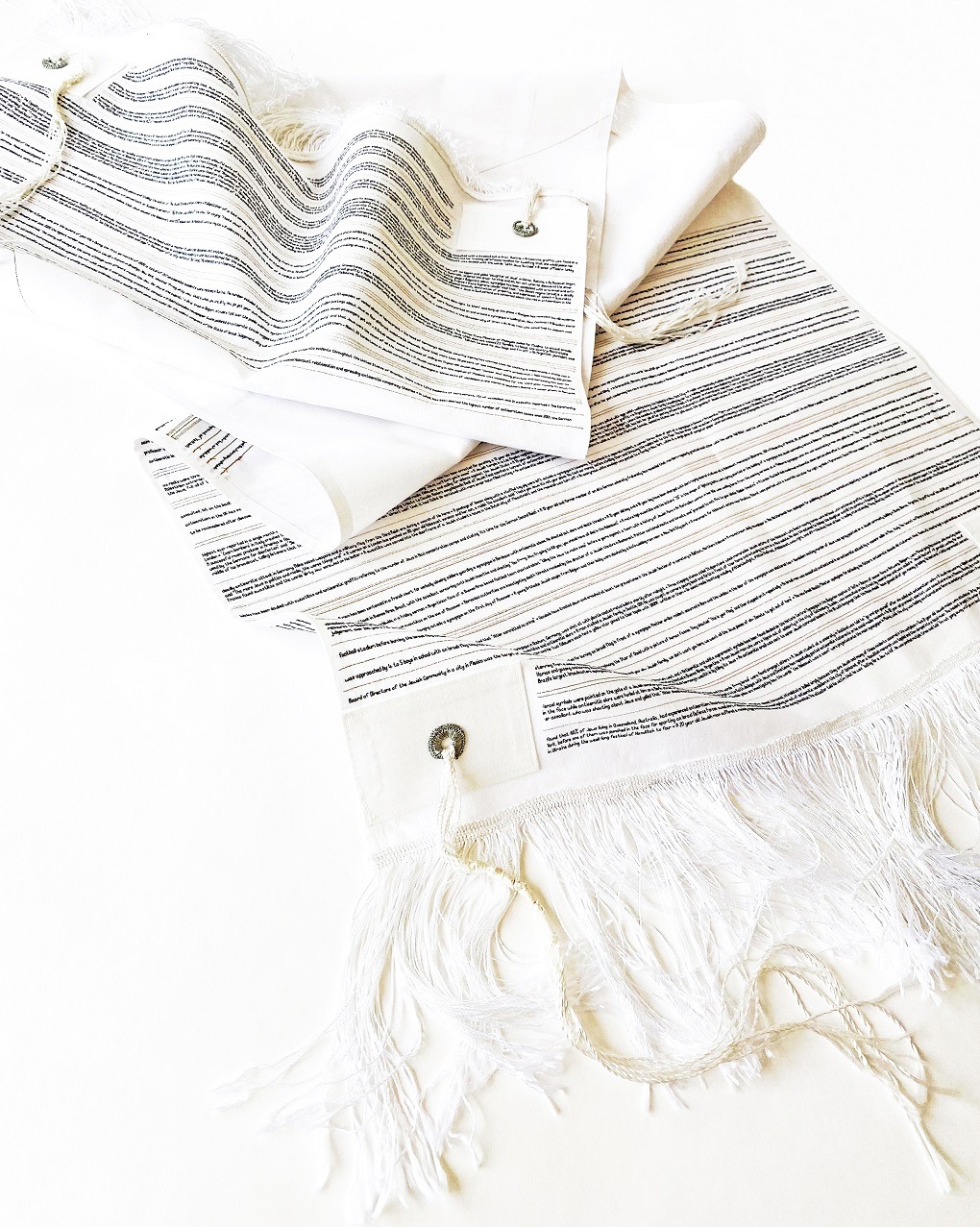
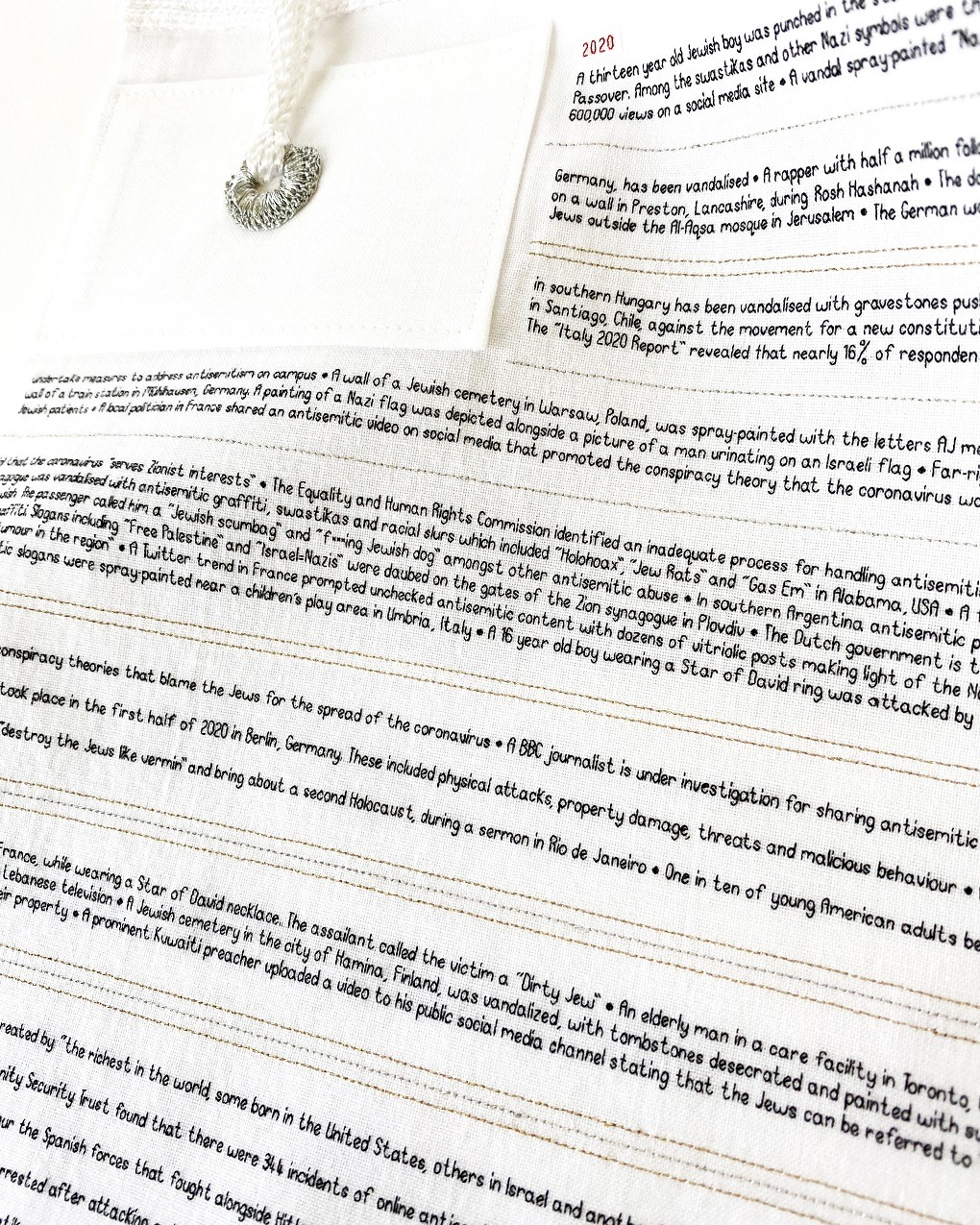
Caren Garfen
The Weight of the World was created by Caren Garfen when she became aware of an upsurge in antisemitism globally. It’s a powerful work, created using back stitch.
‘The size of the stitch really appeals to me. I like the control required when sewing tiny stitches despite the unbelievable amount of time it takes, but it can be challenging when a deadline comes into play!’
Hand stitched text, of antisemitic incidents recorded in 2020 and 2021, creates lines on the fabric. These represent the traditional Jewish prayer shawl, a tallis. At a distance, the pattern appears as bands of black. It is only when the viewer draws in closer that they can see that stripes transform into text.
But this tallis loses its ritual function and is not to be worn, symbolising that Jewish people should not have to carry the burden of antisemitism on their shoulders.
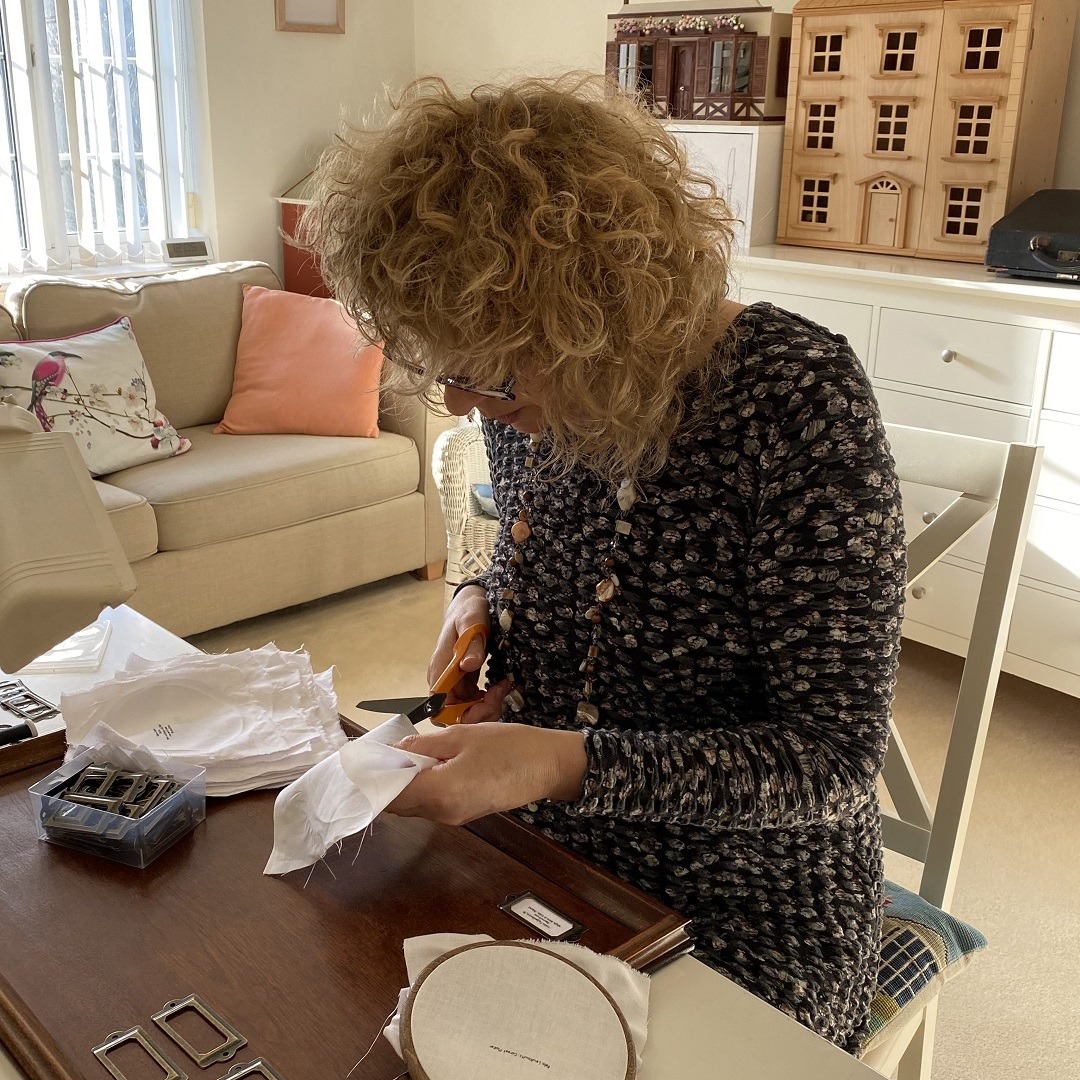
Caren Garfen is an artist specialising in textiles, meticulous hand stitching, and intensive research, creating artworks relating to societal issues. She is based in London, UK. The Weight of the World was shortlisted for the Fine Art Textile Award in 2022. Her work has also been selected for 7th International Riga Triennial of Textiles in Latvia, 2023, and for awards at Art Textiles Biennale, Australia, 2021 and Internationale d’Art Miniature, Canada, 2021.
Artist website: carengarfen.com
Facebook: facebook.com/carengarfenartist
Instagram: @carengarfen
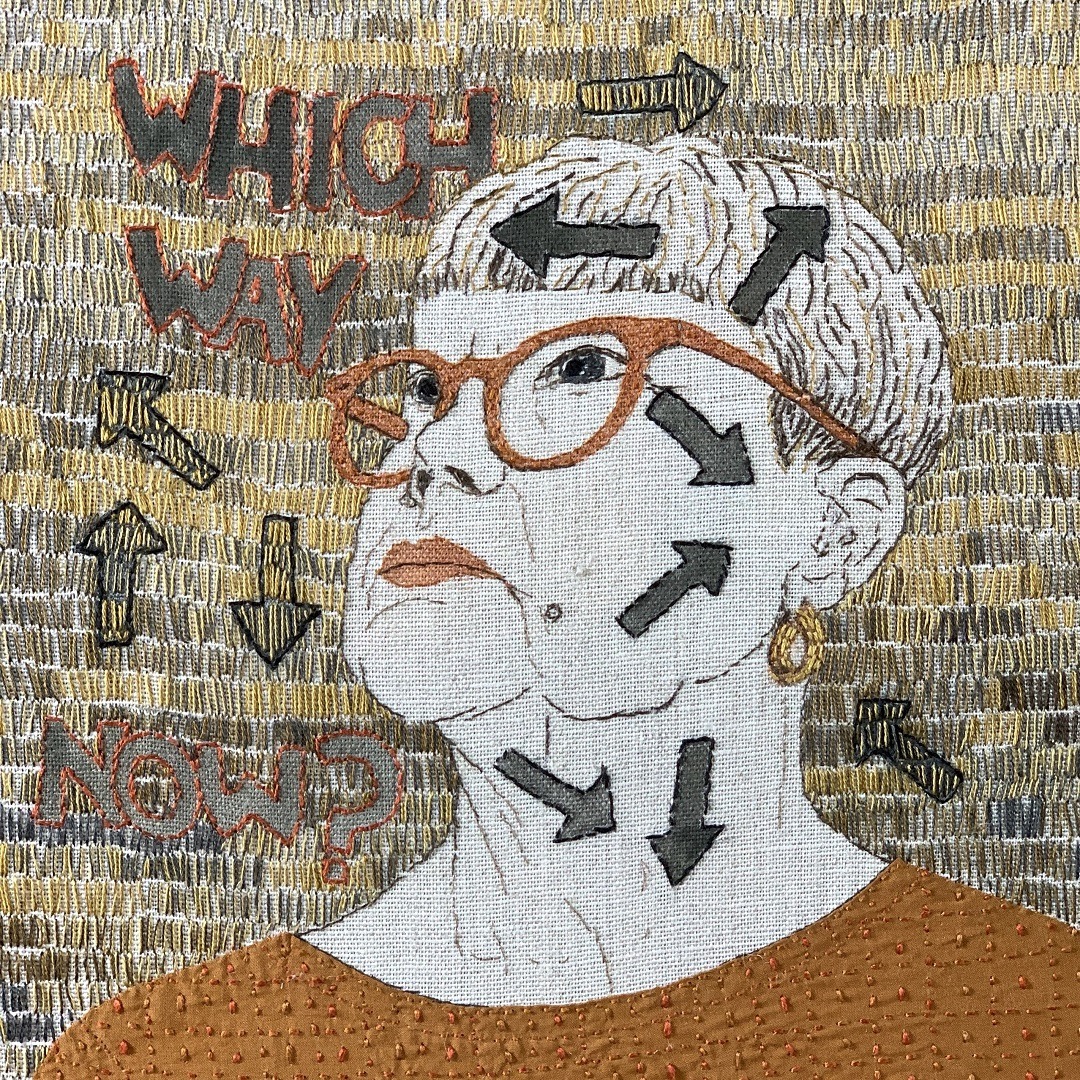
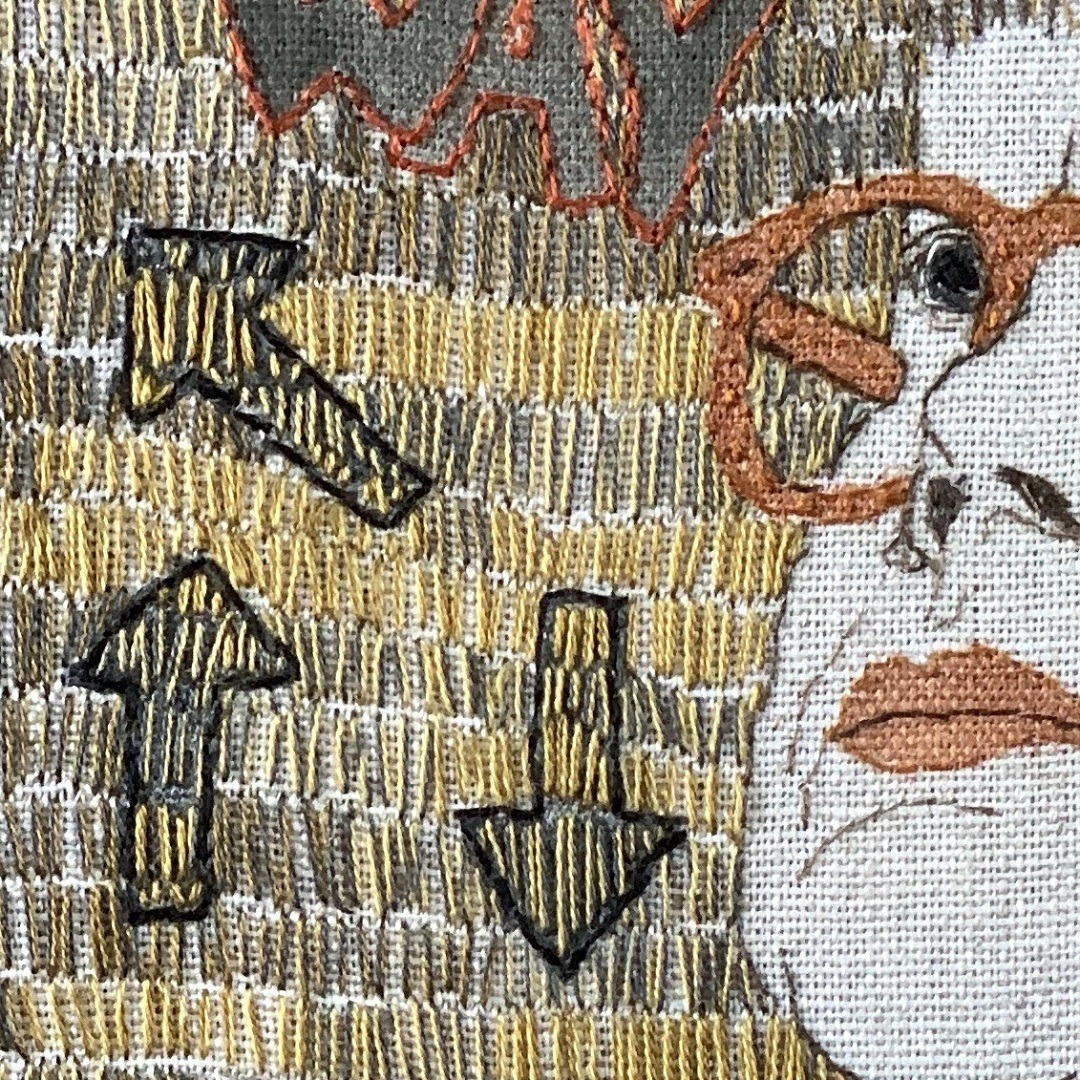
Sue Stone
Sue Stone very rarely uses back stitch in its traditional form, where it is used to make a straightforward, solid line. Although her stitches might be created in the same way, the results are more akin to a drawn line.
In Self Portrait, Number 67, part of an ongoing project, Sue Stone used back stitches to create the hair, face, arrow outlines and dress.
‘What I enjoy about back stitch is the versatility of being able to use it as a mark making tool.’
Back stitches using a very fine sewing thread (such as her favourite Superior Masterpiece thread) can make a delicately nuanced line on a face. Or a single strand of DMC stranded cotton can be used to create an outline drawing or a sketchy, broken line.
Sue also makes the most of six stranded embroidery threads, using anything up to six strands of DMC embroidery thread to create patterns. With back stitch the thread wraps around both the back and front of the fabric. This makes it become slightly raised up on the front of the cloth, giving some amazing surface texture when using the full six strands. Sue tells us that no other stitch is more useful for her work than back stitch.
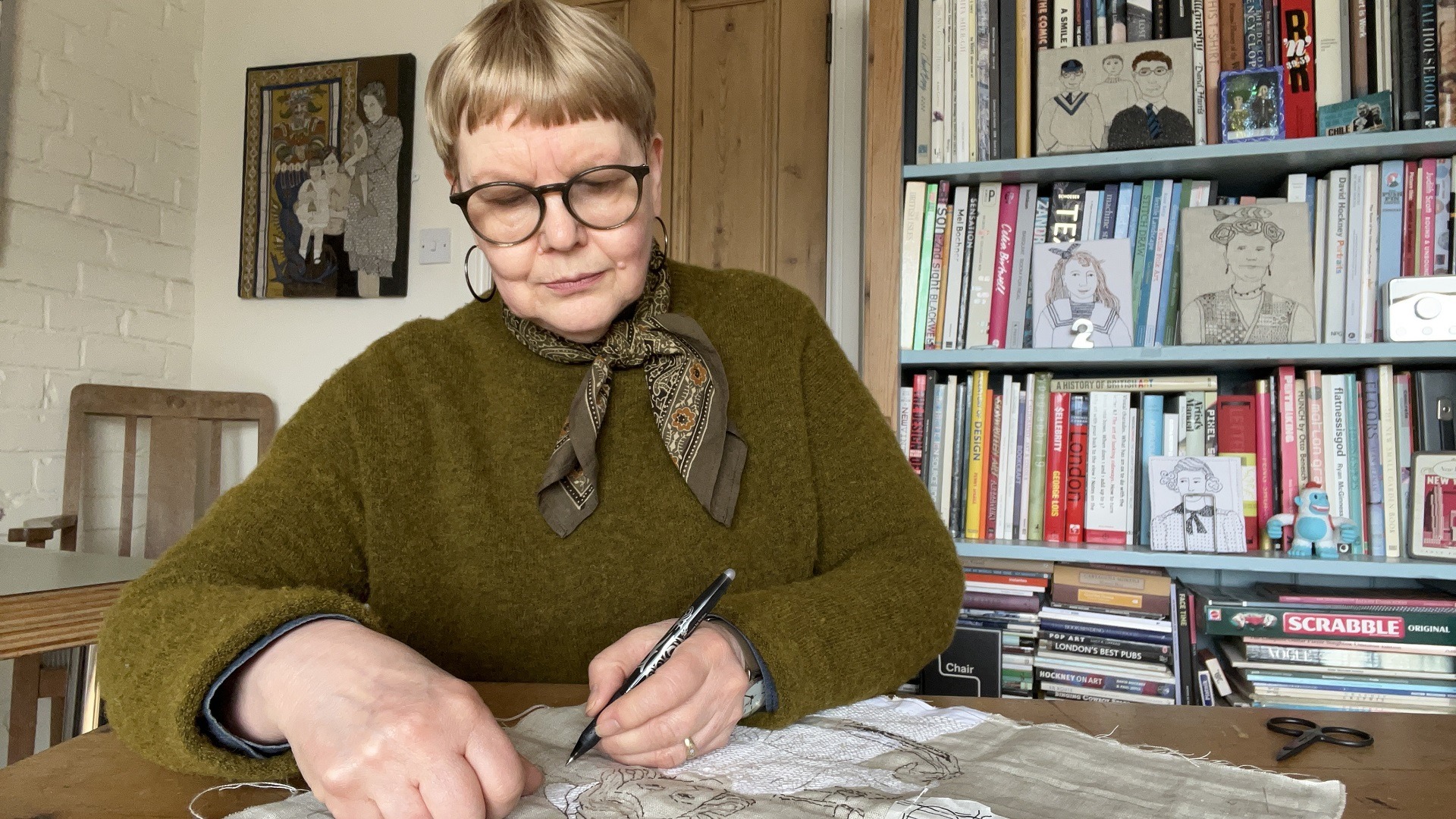
Sue Stone is based in the UK, and is a member of the 62 Group of Textile Artists, and a Fellow of the Society of Designer Craftsmen. Her work has been exhibited worldwide, including at her solo show Shifts and Allusions, at The Hub, Sleaford in 2023, at the 12th From Lausanne to Beijing International Fibre Art Biennial Exhibition (2022), and as part of the 62 Group’s exhibition at the Knitting & Stitching Show (2022).
Artist website: womanwithafish.com/
Facebook: facebook.com/suestone.womanwithafish
Instagram: @womanwithafish
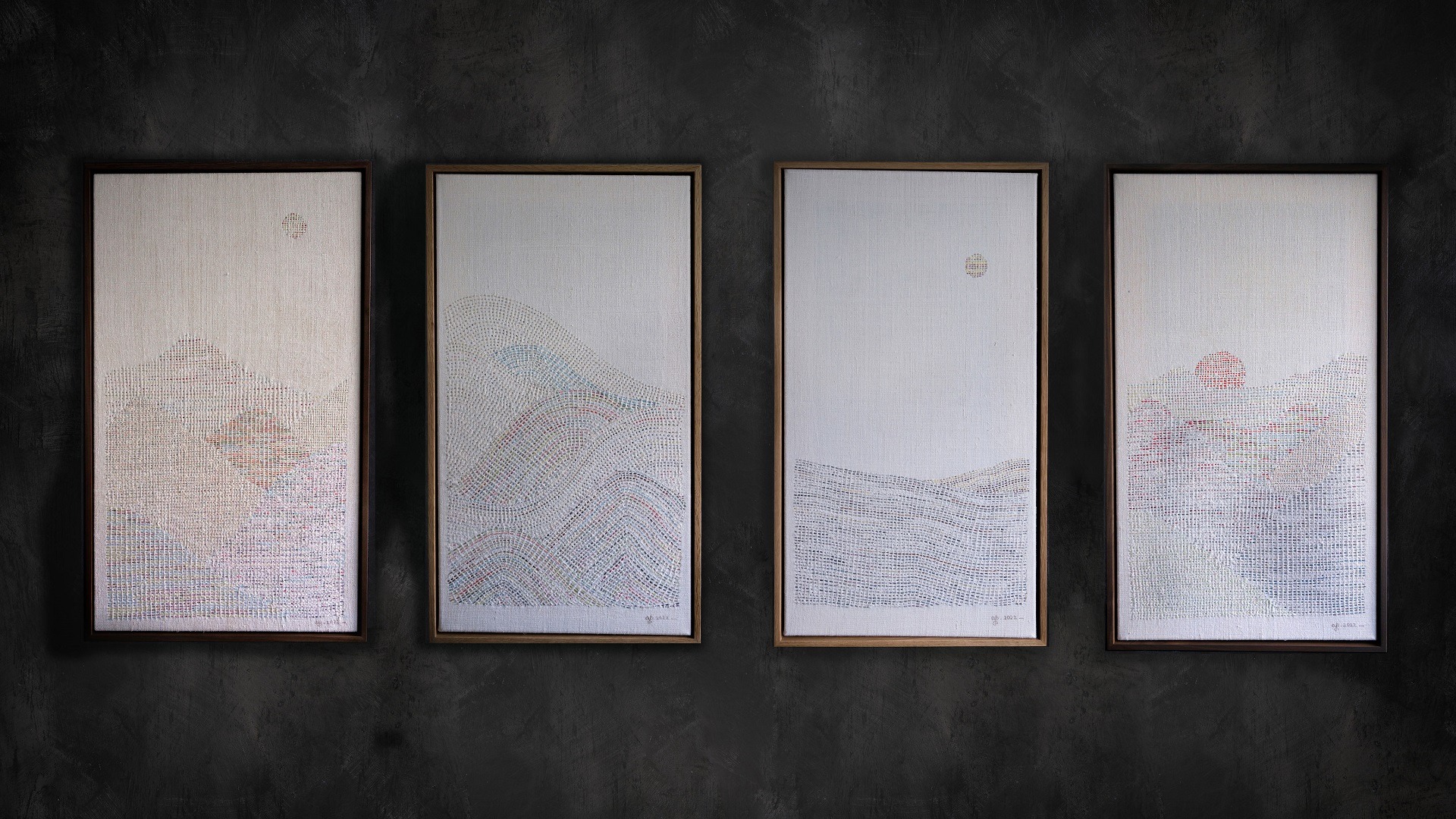
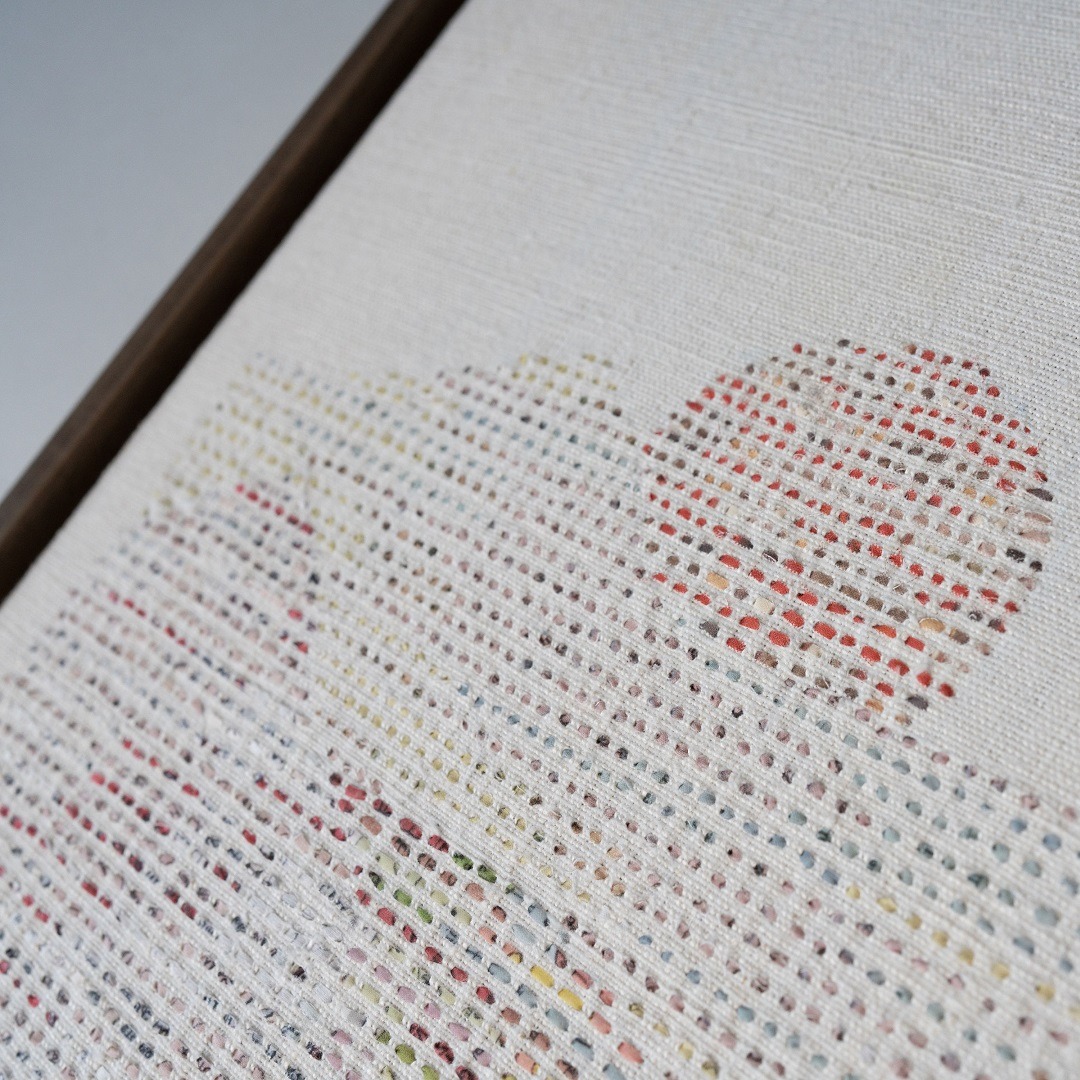
Archana Pathak
In her series Reimagined Landscapes, Archana Pathak creates orderly rows of straight stitches, arranged into landscapes using subtle blocks of colour.
Archana often works with found memory artefacts. In this series, by using old maps, she is able to consider the evolving nature of boundaries, both physical and psychological, and the identities being reshaped. And when she transforms the maps into landscapes, her artworks become harmonious representations of co-existence and connectedness.
First, a collection of old maps are printed onto fabric – recording lost, found or longed-for places. From these, she cuts very fine laces, using them to slowly render the landscape’s contours.
She began making Reimagined Landscapes in mid-2021, at a time near to the end of the lockdowns in the UK.
‘I was experiencing a sense of calm in using just straight stitches in my work. The nature of simple repetition was a gift and natural progression, for me to heal, to make sense and to start again.’
Drawn to simplicity and essentialism, Archana’s work carries questions, insights and hope – her art explores her identity and is influenced by the many things she’s trying to make sense of.
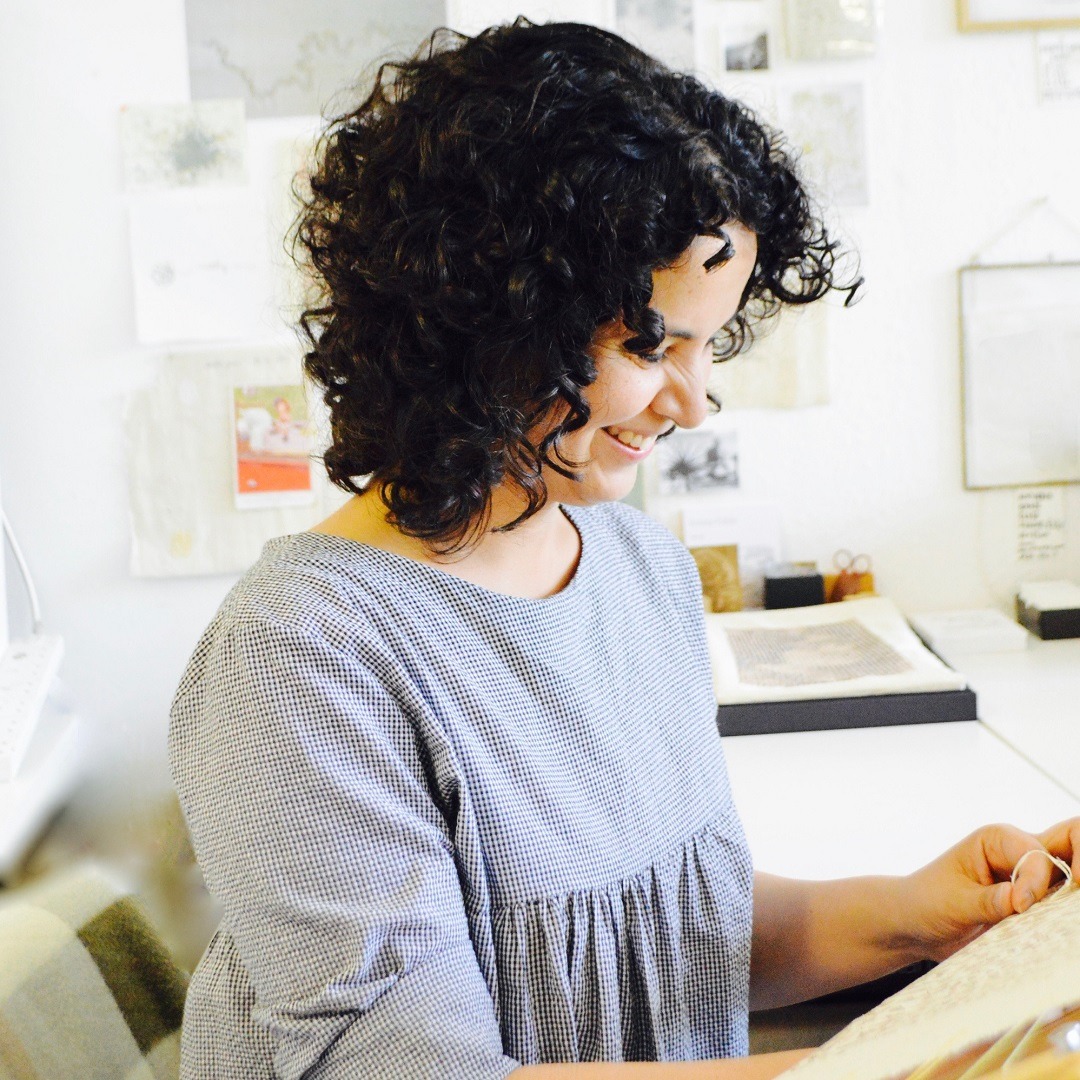
Archana Pathak is a fine art textile artist based in London, who draws inspiration from her British and Indian heritage. Archana exhibited in a solo show at The Textile Galleries, The Knitting & Stitching Show, 2022. She was The Needlemakers Company Award winner at Cockpit Arts, 2022, and was shortlisted for the Brookfield Properties Crafts Council Collection Award, 2021.
Artist website: archanapathak.com
Instagram: @archanapathakartist
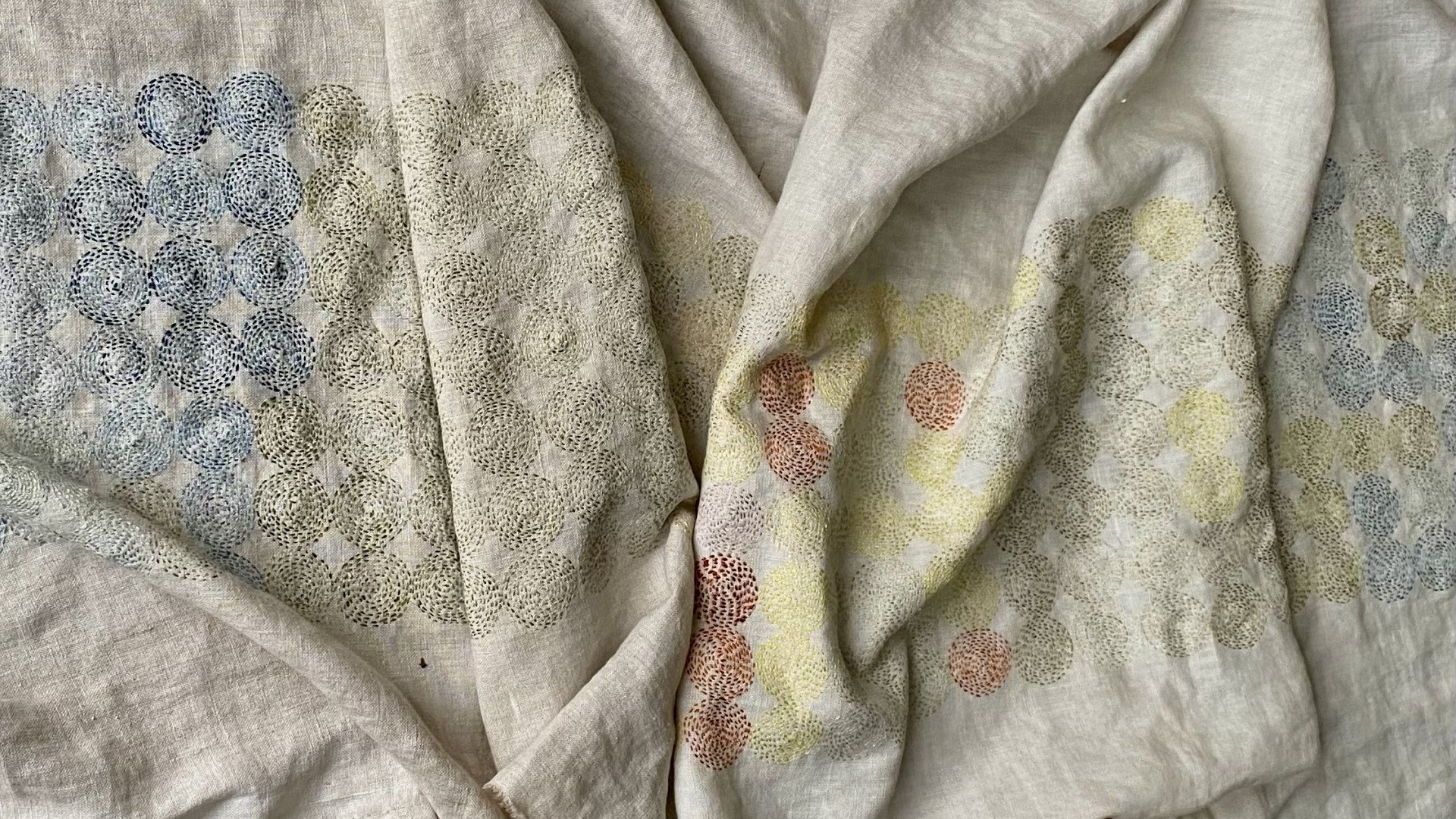
Claire Wellesley-Smith
Claire Wellesley-Smith’s meditative running stitch work Shift uses a colour palette determined by the plants on her urban allotment plot – she dyes the silk thread in small batches using plants she’s grown herself. The dye colours shift through the year as different plants come into season, which include indigo, madder, dyer’s chamomile, cosmos and onion skins.
Using stitch to explore the connections between green spaces and wellbeing on her own health and that of others, her work is an exercise in rhythm and observation.
‘Over the years I have come to understand the rhythm of my running stitches, the stitch length and patterns that I fall into when I spend time with this repetitive action.’
Stitching offers Claire a space for reflection on her working life, the dye processes she uses and her affinity with the allotment. The creation of Shift marks the 10th anniversary of her growing food and textile dyes at her allotment, while also celebrating her daily Stitch Journal, which she has worked on since 2013.
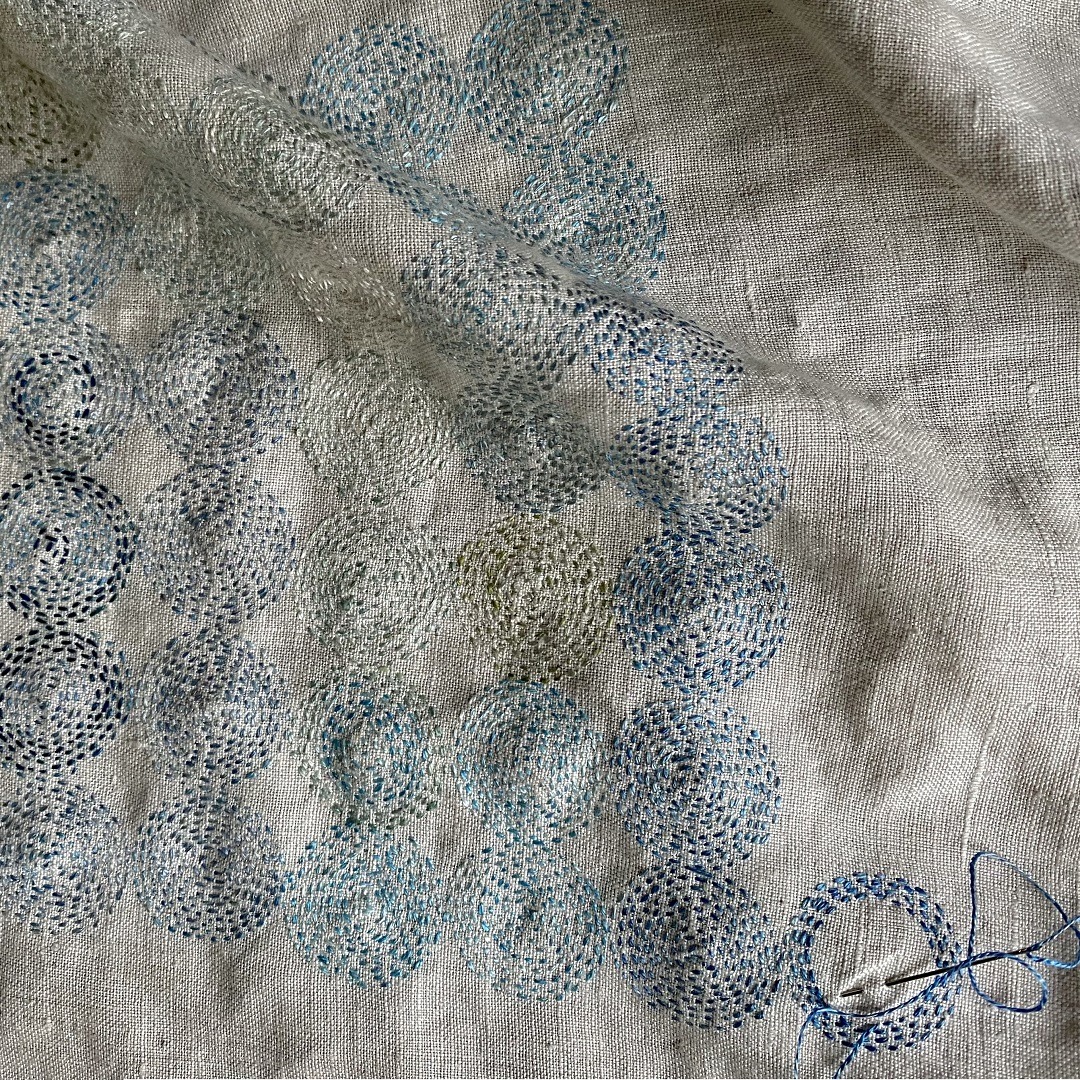
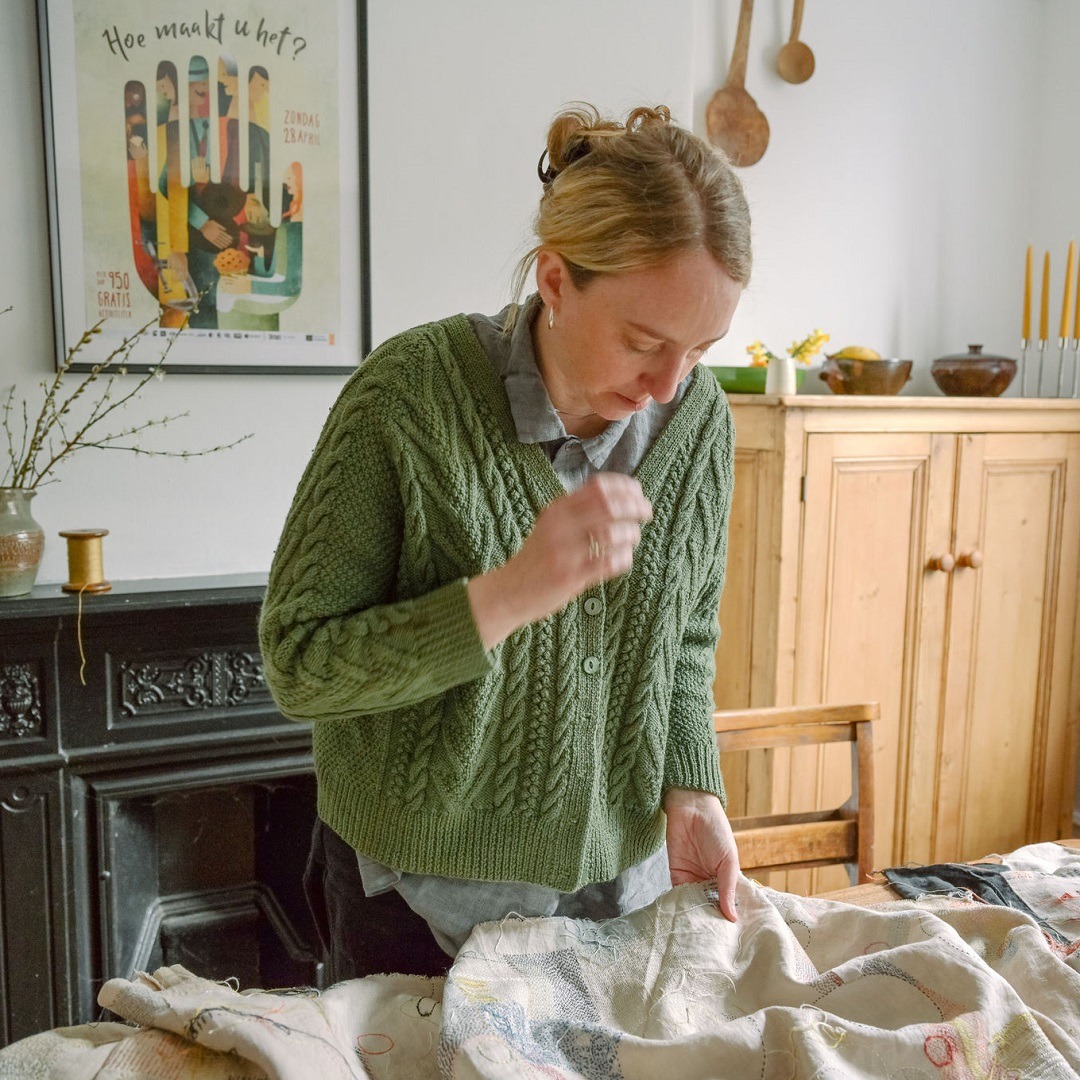
Claire Wellesley-Smith is an artist, writer and researcher based in Bradford, West Yorkshire, UK. Her work is informed by the ability of textiles to transform and connect over time, and her projects embrace the arts, heritage and community wellbeing sectors. Claire is the author of Slow Stitch: Mindful and Contemplative Textile Art (2015), and Resilient Stitch: Wellbeing and Connection in Textile Art (2021), both published by Batsford.
Website: clairewellesleysmith.co.uk/
Instagram: @cwellesleysmith
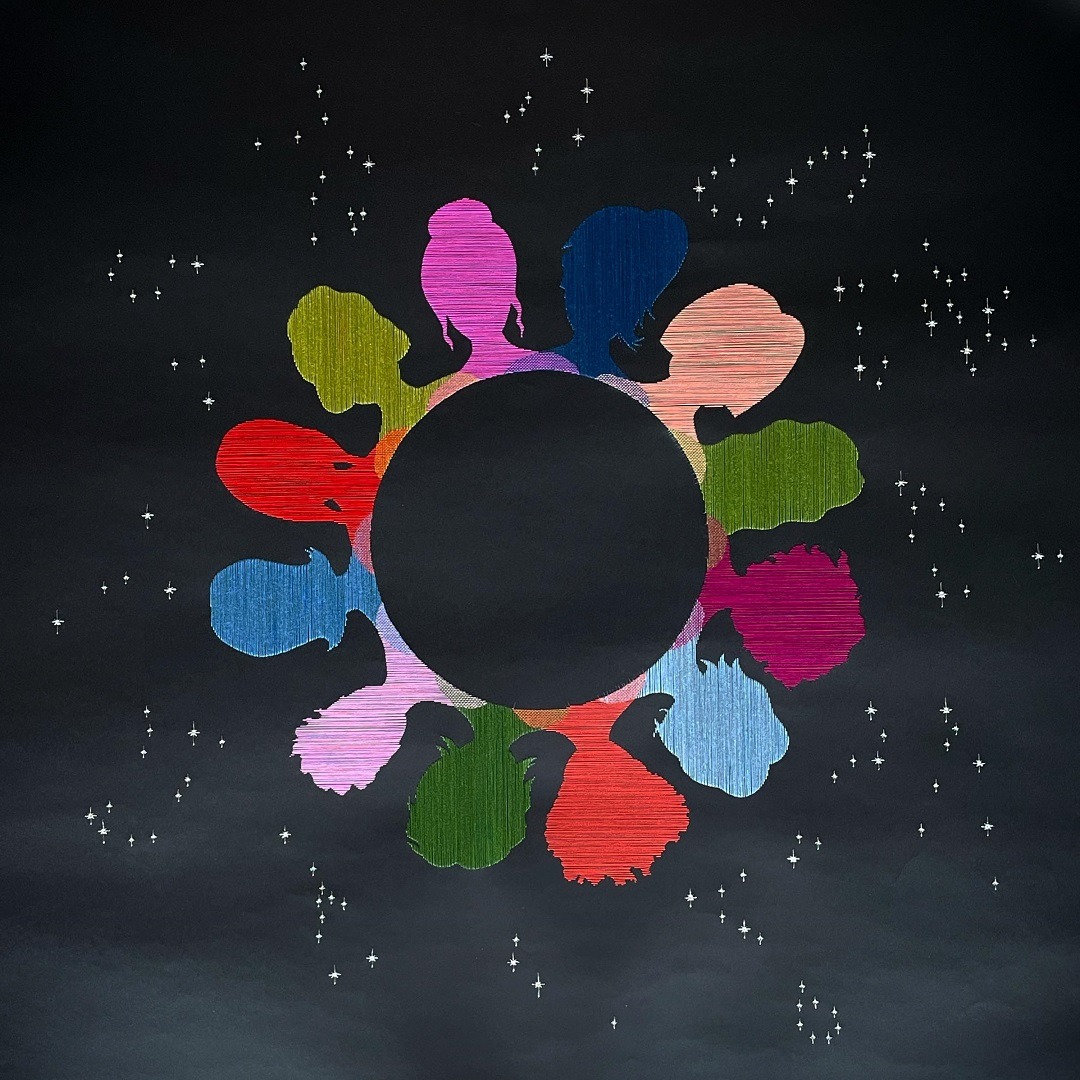
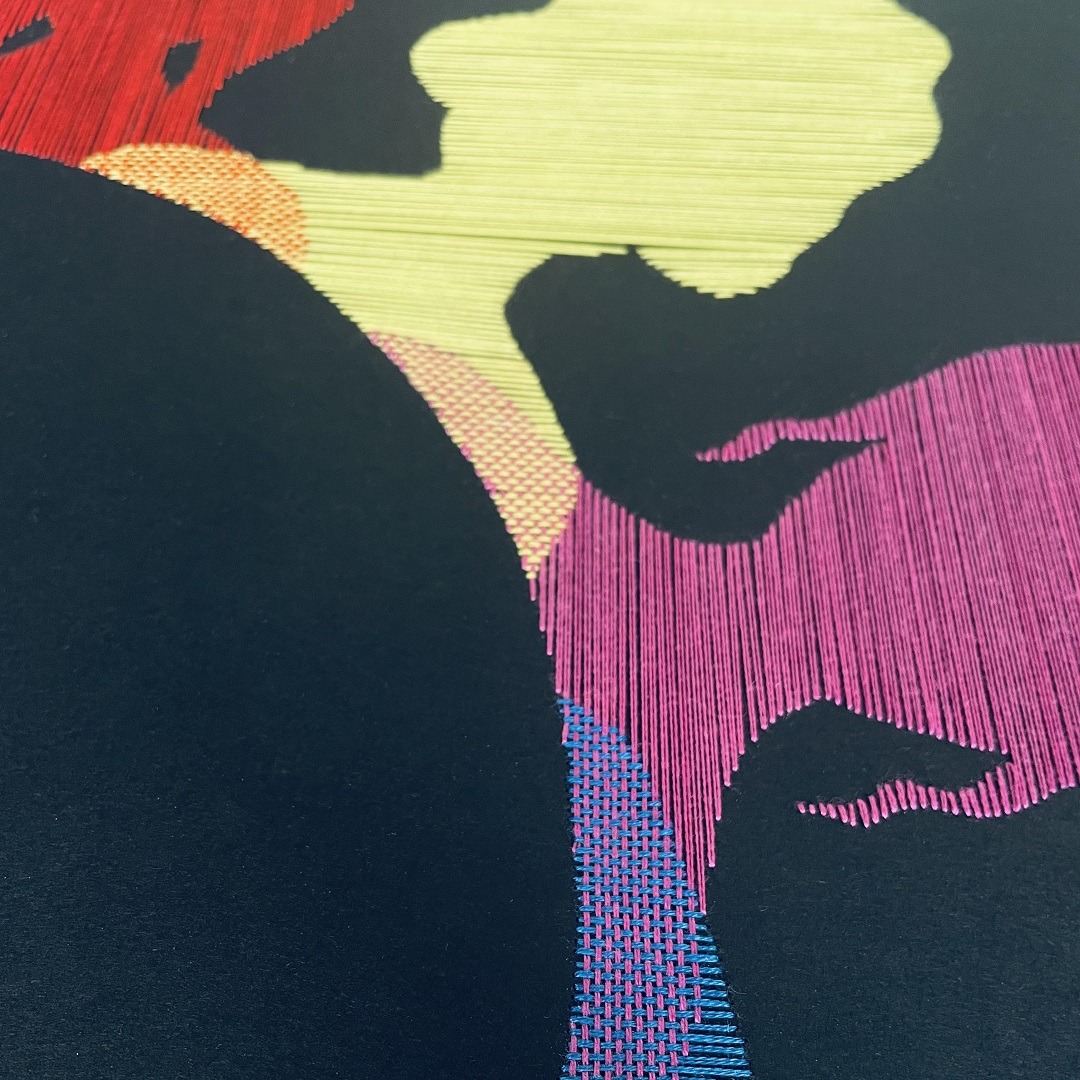
Yuka Hoshino
Long straight stitches create a strong graphical element in Space as Time, by Yuka Hoshino.
This work contemplates the role of the stars and planets as intergenerational links, important navigational tools and markers of time. The positions of constellations and heavenly bodies were of central importance to ancient societies. And with advancements in space exploration and the resurgence of astrology in pop culture, the human relationship with the night sky persists.
After seeing the work of Nicolas Moufarrege, Yuka began to experiment with long straight stitches.
‘A bit of play quickly led me to change the direction of the stitches so that they might be interwoven. I love the often unpredictable subtleties of colour and texture that result from this slow manual weaving.’
Yuka represents the invisible bonds between women of successive generations by interweaving the stitches where the silhouettes overlap. She also notes that the woven stitches can signify those times where two people might seem to be at crossed purposes, or be ‘perpendicular’ to one another, but when this incongruity often results in a stronger, dynamic relationship.
In contrast with the long, colourful stitches, the central section of the work will be completed with a moon motif, stitched separately. This is rendered in a single running stitch forming a continuous loop, representing the infinite interconnectedness of all things.
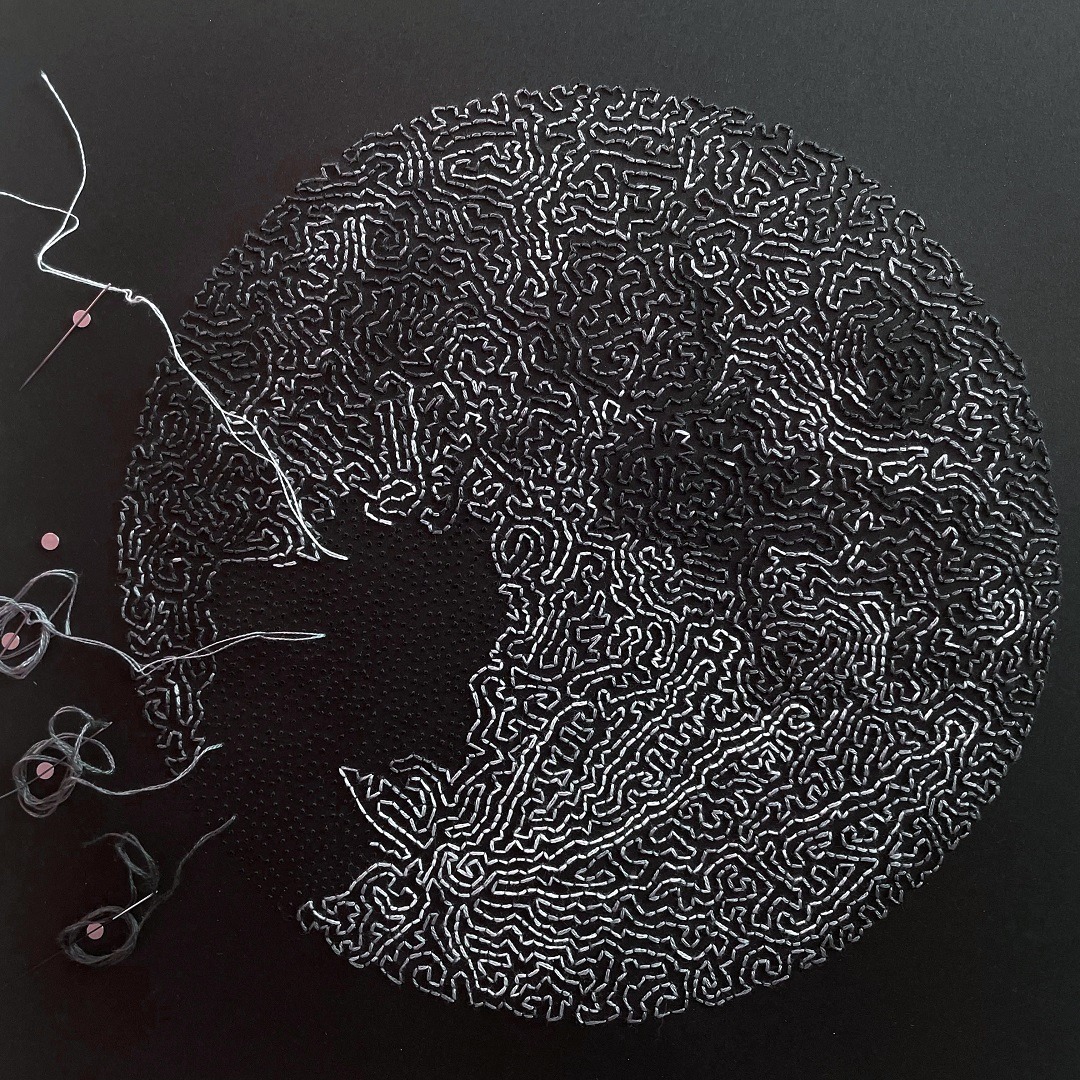
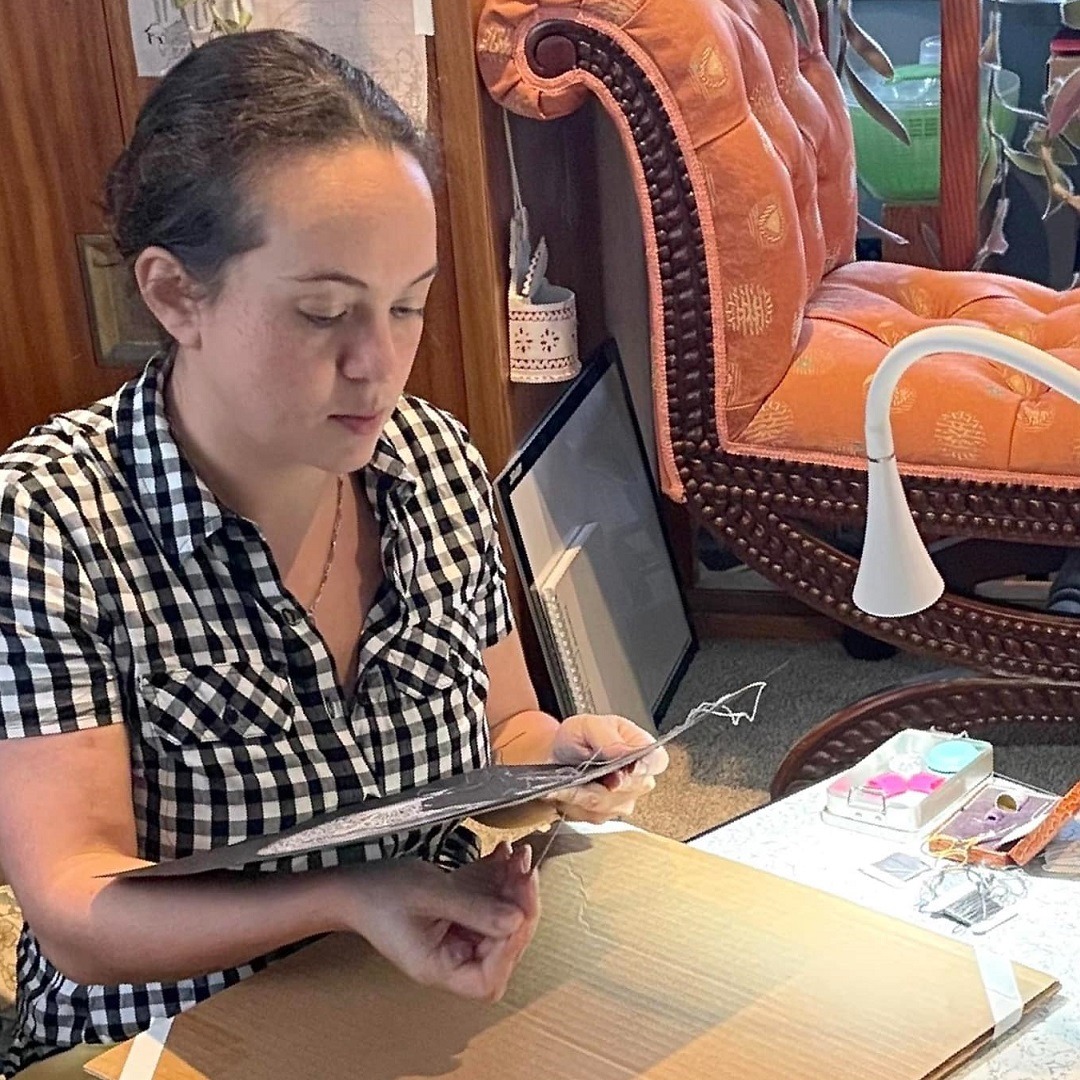
Yuka Hoshino is a paper embroidery artist based in Sonoma County, California, with a background in environmental archaeology. Her work often explores the themes of place, identity and botany, which were also central to her previous work as an archaeobotanist on excavations throughout Central Asia and the Middle East.
Artist website: mayukafiberart.com
Instagram: @mayuka.fiberart
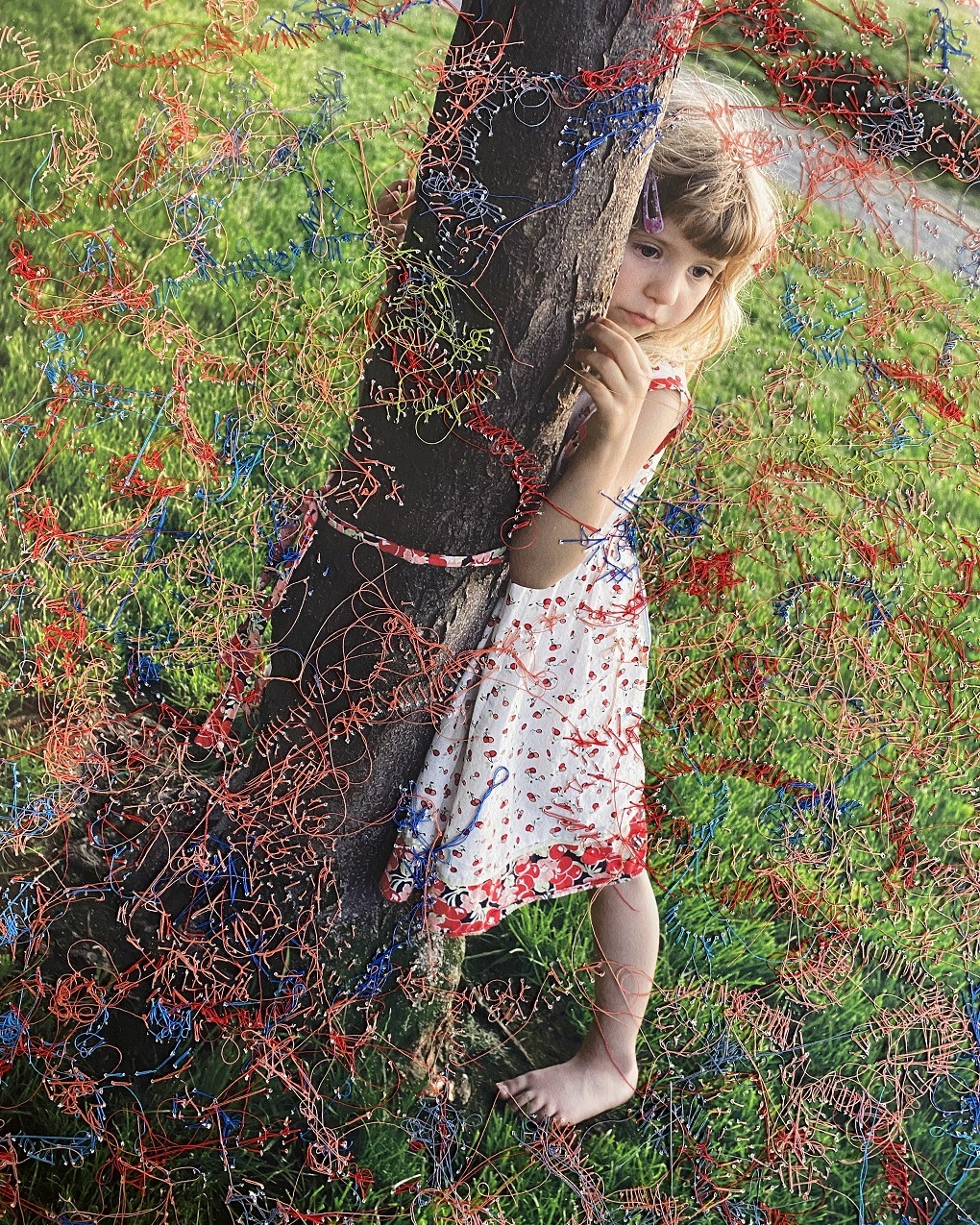
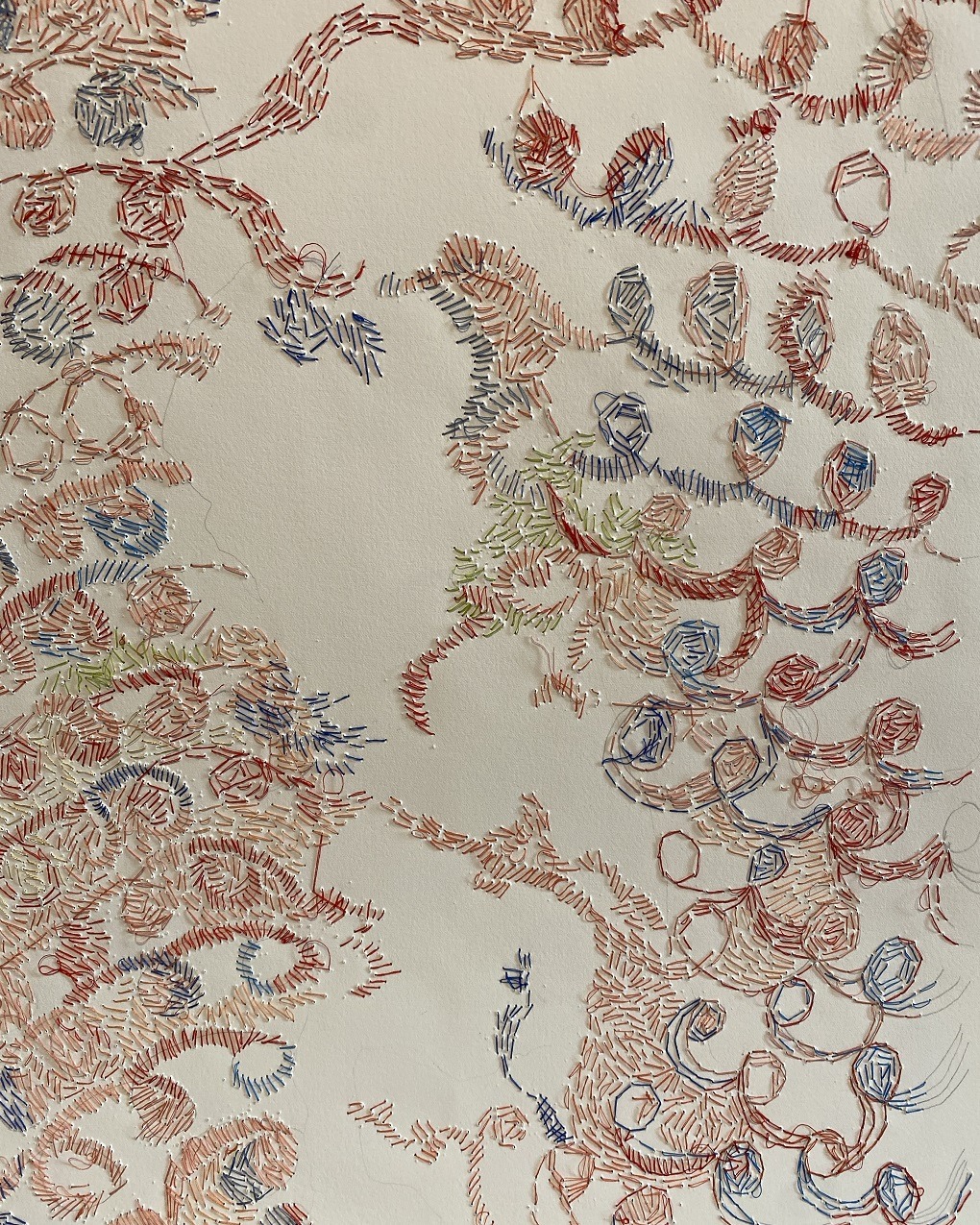
Melissa Zexter
Melissa Zexter chooses a strong photographic image, often of a woman or a girl, and stitches it, while working from the reverse and from the front simultaneously.
In Girl and Tree, straight stitches create a dynamic swirling pattern on the back, and small areas of running stitches have been added to the front. This process results in a loose, textured and multi-layered effect that’s full of energy
‘Sewing from the reverse creates a more three-dimensional look. The thread has a life of its own. When I am sewing without seeing the front of the image and then I turn it over, the results are often a surprise.’
This abstract process of stitching encourages further reflection upon the combination of the two mediums. Melissa can explore the material status of the photograph as a three-dimensional, hand-crafted object, while also examining issues of identity, memory, and technology.
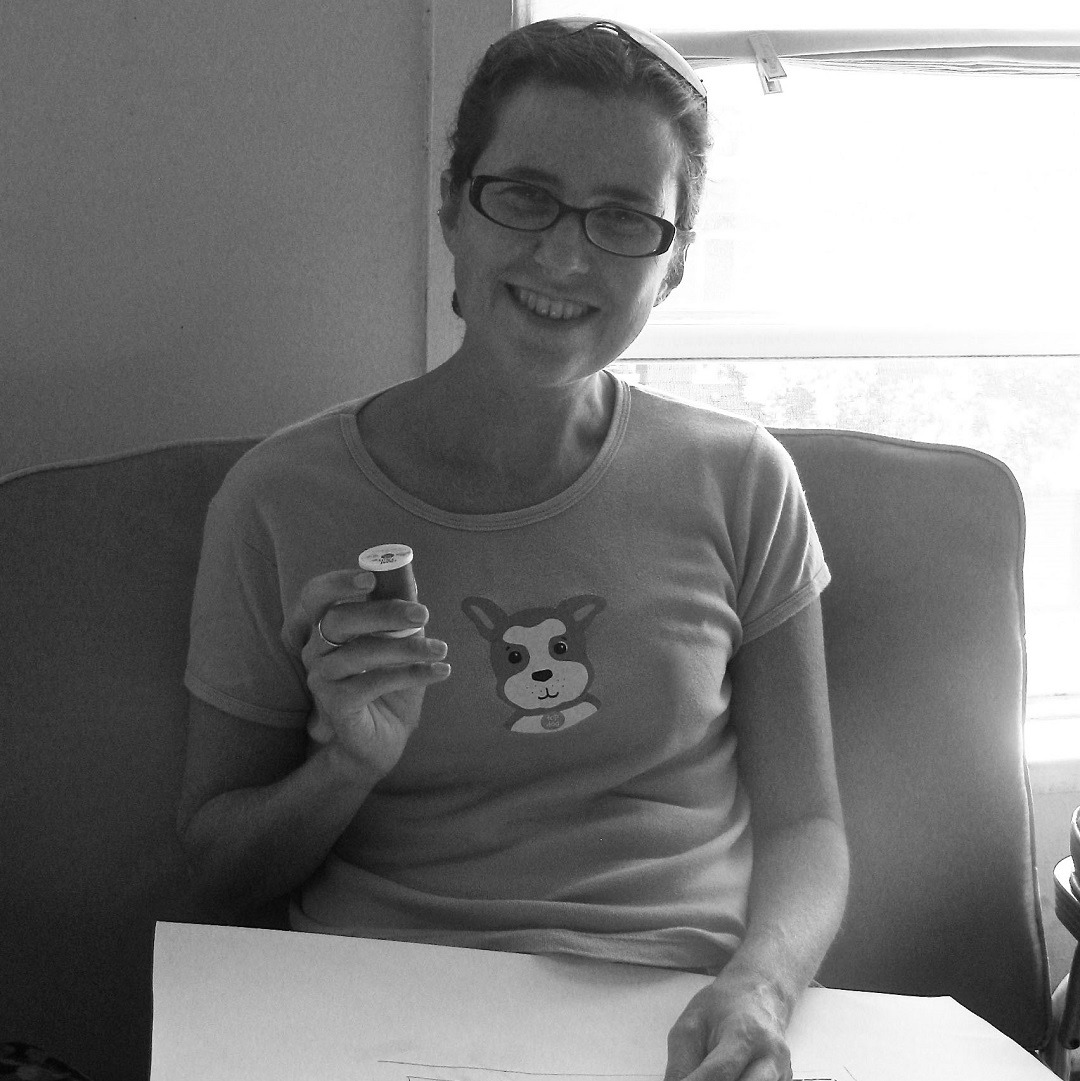
Melissa Zexter is a photographer and textile artist based in Brooklyn, New York, USA. She has been combining these two very different art forms for over 20 years. She exhibits her work regularly throughout the USA and in Europe.
Artist website: melissazexter.com/
Facebook: facebook.com/MelissaZexterPhotography
Instagram: @melissazexter
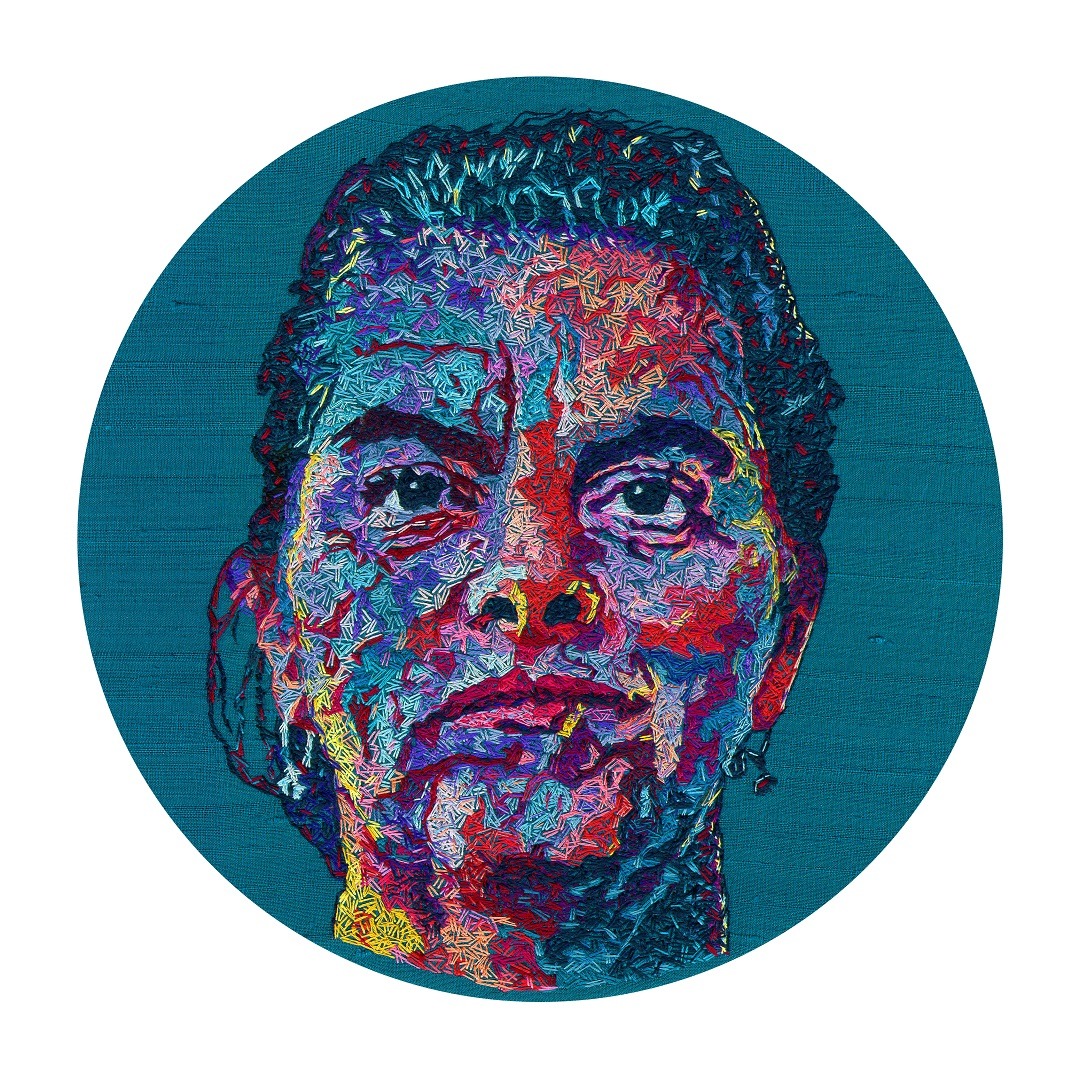
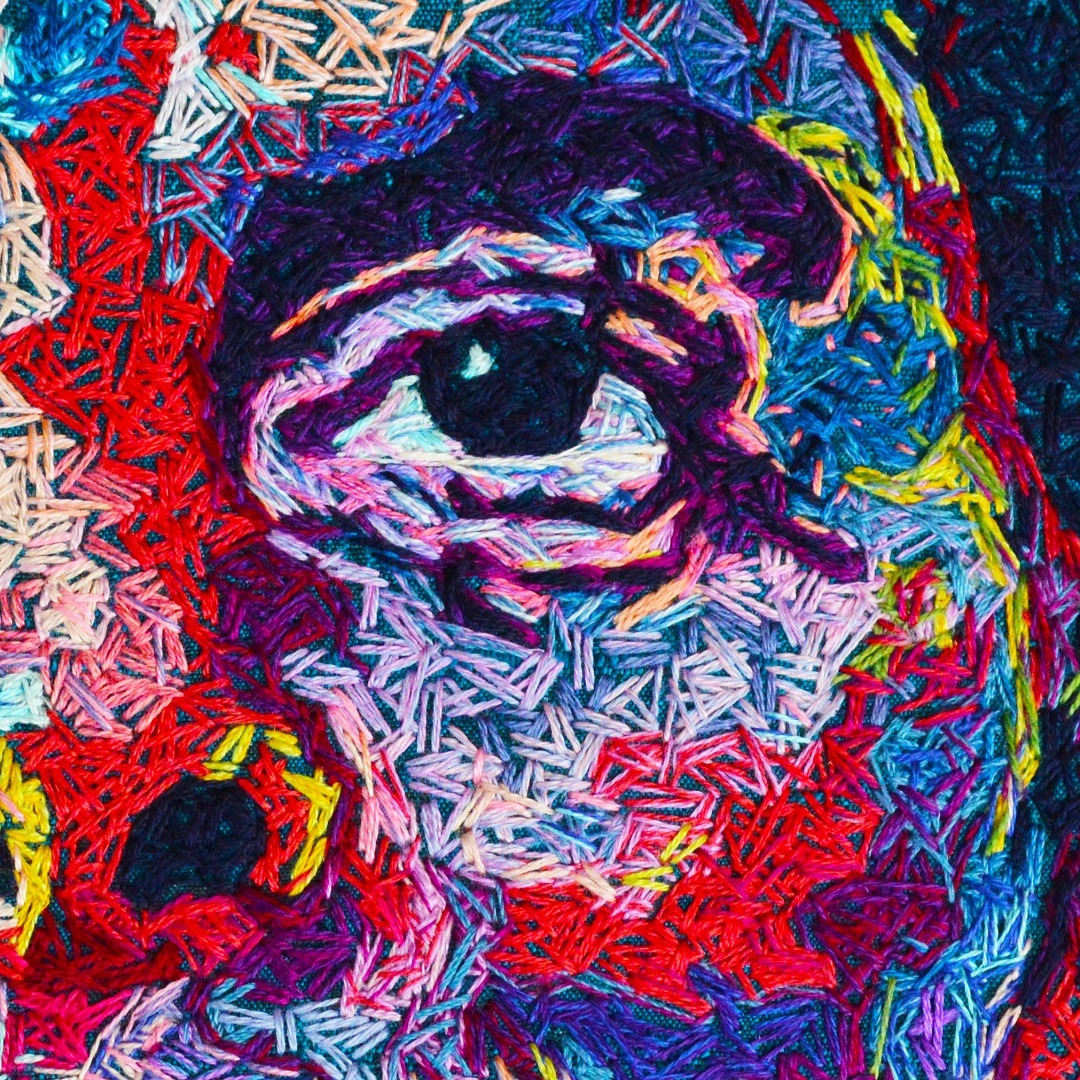
Claire Mort
In Claire Mort’s bold-coloured seed stitch portrait, Tracey Emin – Olympia, the subject sports a strong and defiant glare. Tracey Emin’s work featured in the The Sensation Exhibition in 1997 and changed Claire’s life forever – for this was the moment Claire knew she was meant to be an artist. And so, as a huge fan, Claire was keen to stitch Tracey’s portrait.
Claire’s favourite technique is seed stitch and she reminds us that, as Constance Howard once said, you don’t have to know lots of stitches, you just have to use the ones you do know, well. She enjoys the labour-intensive side of seed stitch, feeling a real affinity with this detailed way of working.
‘There are lots of stitches I could have used to make my work quicker, but I love the time it takes to create a piece of work using tiny stitches. Most of my pieces take over 200 hours. For me it’s all about the slow process.’
The portrait explores multi-layered meanings for women everywhere, from judgement, to shaming, and everything in-between. Pictured with a confrontational stare, similar to Manet’s Olympia, Tracey is depicted staring down the art world, and being true to herself.
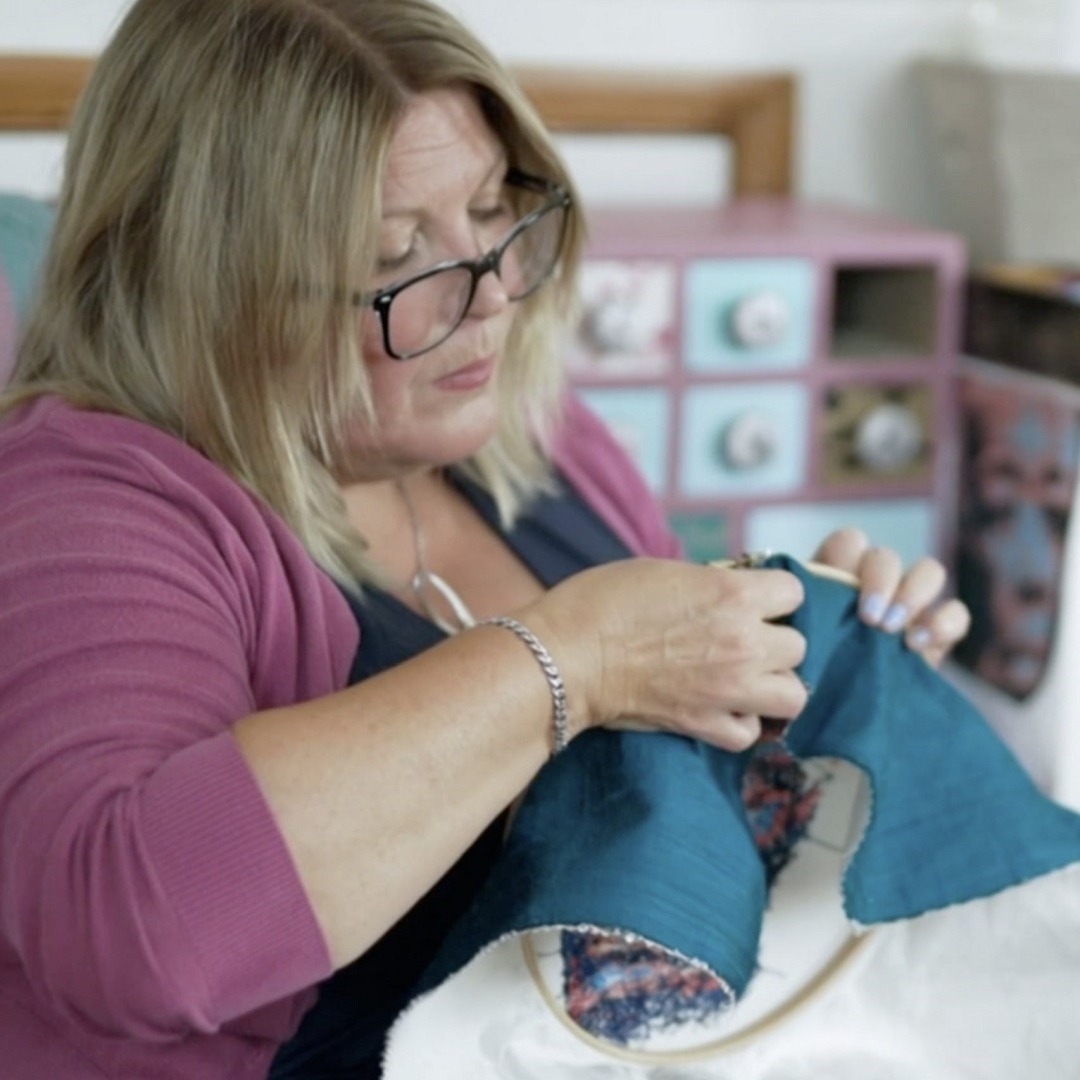
Claire Mort is a British textile artist, based in Dorset, UK. She was featured on BBC Two’s Royal Academy Summer Exhibition Show in 2022. She is a member of Prism Textiles and the Society for Embroidered Work.
Artist website: clairemortartist.com/
Instagram: @clairemortartist
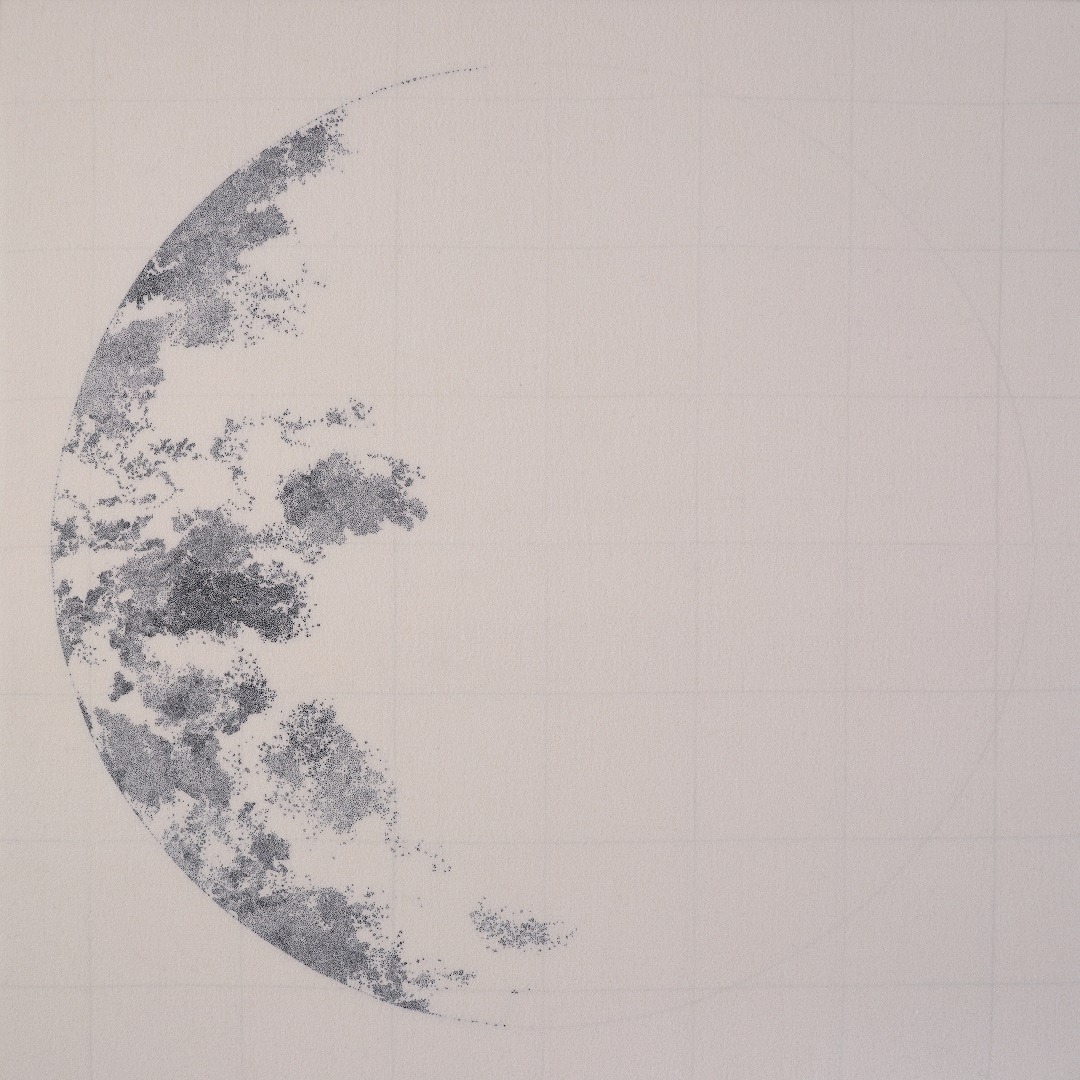
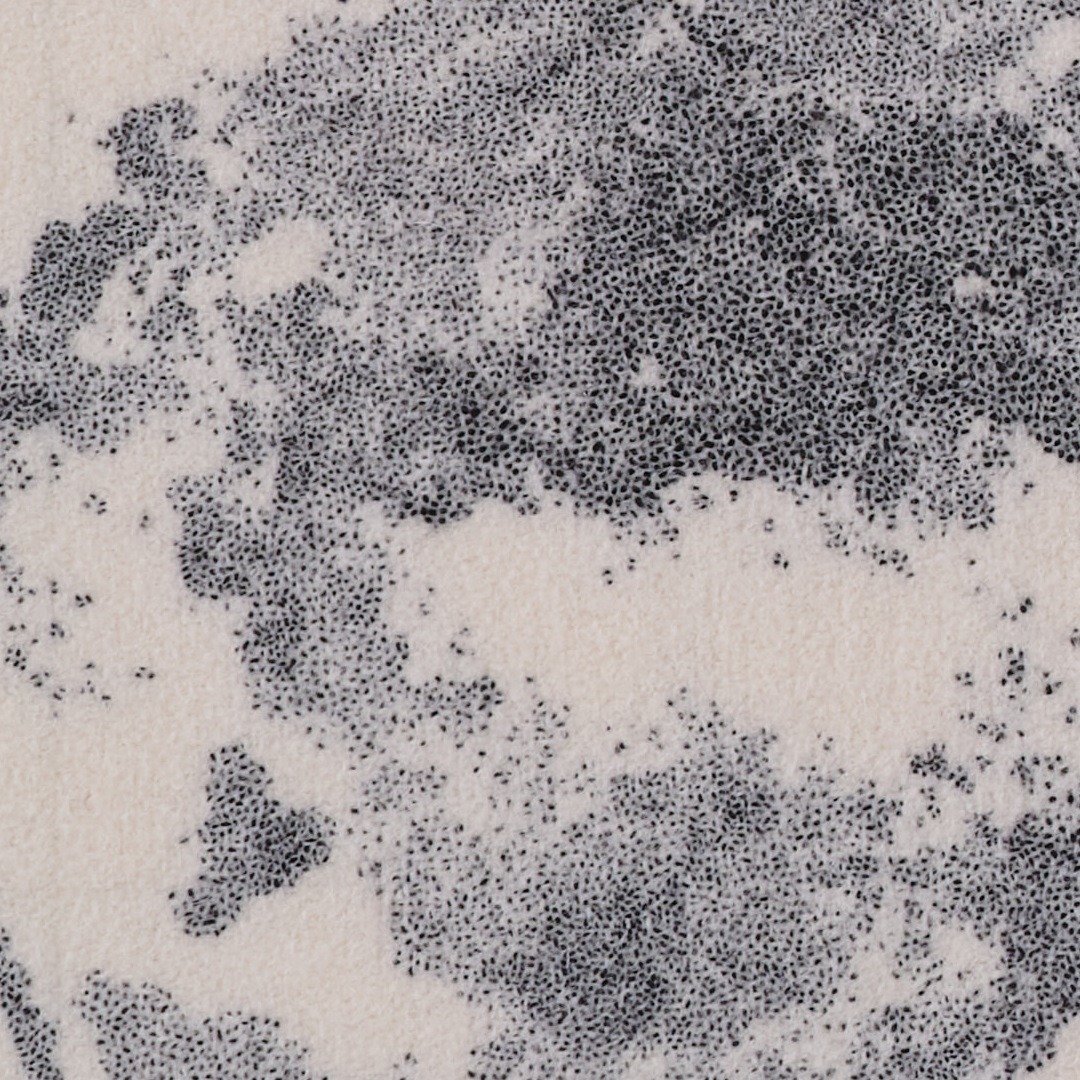
Richard McVetis
Meditation on Process by is work driven by stitch and time. Tiny seed stitches nestle into the soft wool flannel ground fabric that Richard McVetis loves to stitch.
Richard’s ideas are often developed in response to a moment. Stitch is used to transform time or a place into a tactile and tangible object. Through his process he can visualise, consider and occupy a space, measuring and marking time.
His embroidery work is a truly meditative process. It deeply embodies his presence. He becomes immersed in the experience of making, firmly rooted in the physical act of repetitive stitching.
For Richard, the appeal of seed stitch has always been about drawing – the similarities between pen on paper, and thread on fabric – and the immediacy and directness of mark-making.
‘The richness of seed stitch is in its simplicity, versatility and potential to come together in infinitely different configurations to express and describe the world around me.’
Using the density of the stitches to understand a space or subject matter, Richard has gained a deep connection with this simple stitch, that he has come to know so intimately. It offers him more than just a mark on fabric, but an insight into how to be.
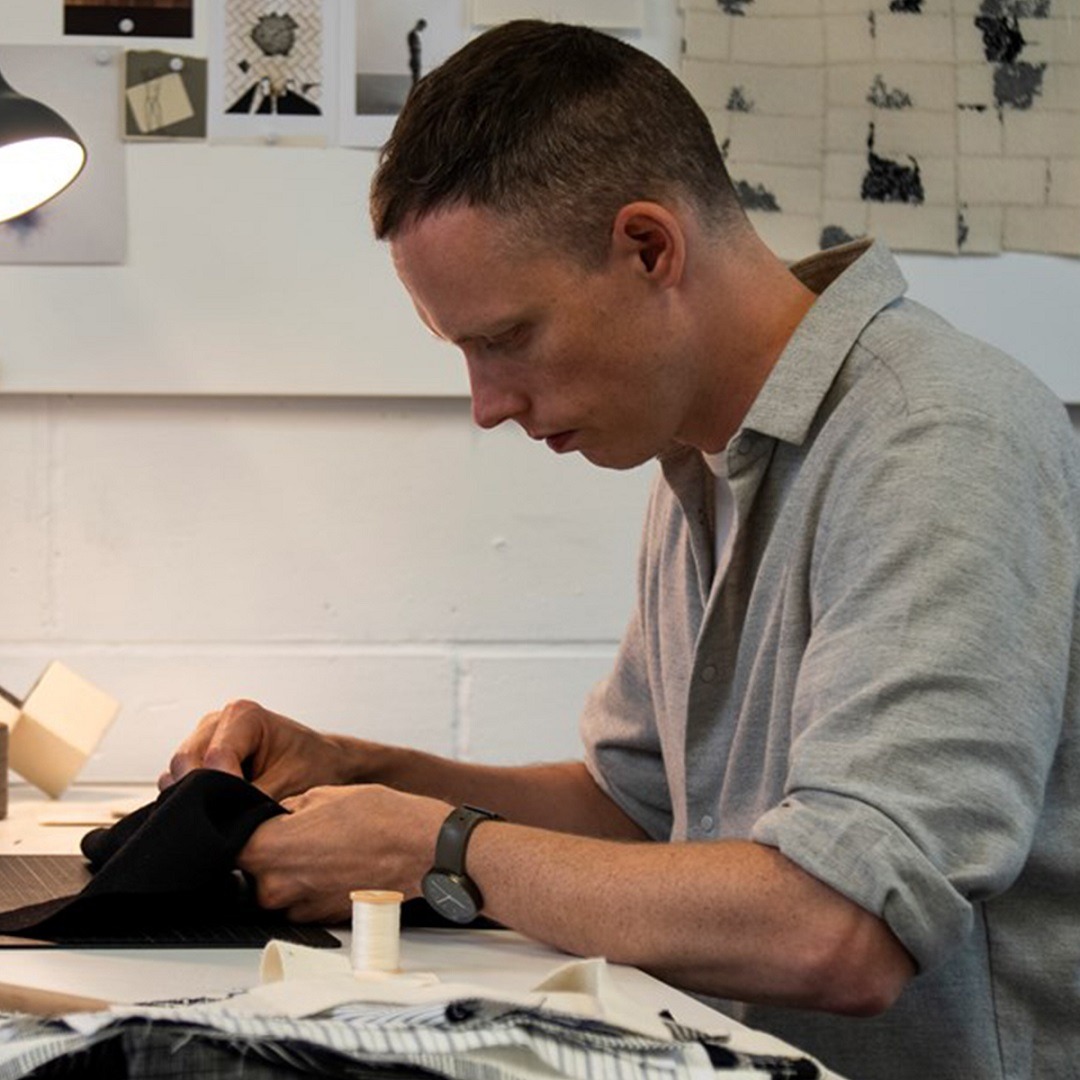
Richard McVetis is an artist based in London, UK. He is a member of the 62 Group of Textile Artists and a visiting lecturer in Textiles at the Royal College of Art, London. He exhibited at The British Textile Biennial (2021), RENEW at Kettle’s Yard (2019) and his solo show Shaped by Time, opened at the Craft Study Centre in Farnham (2022).
Artist website: richardmcvetis.co.uk
Facebook: facebook.com/richardmcvetisart
Instagram: @richardmcvetis
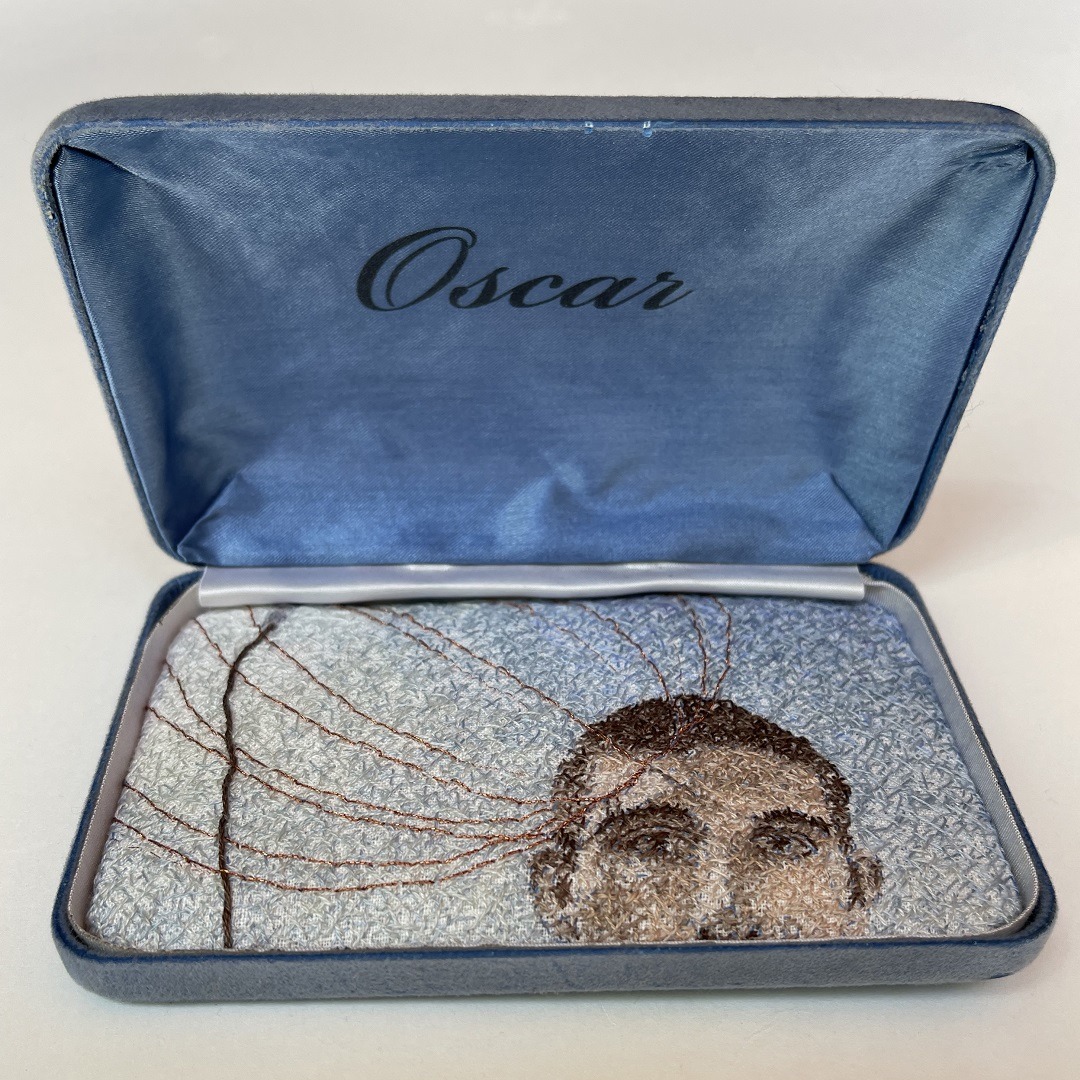
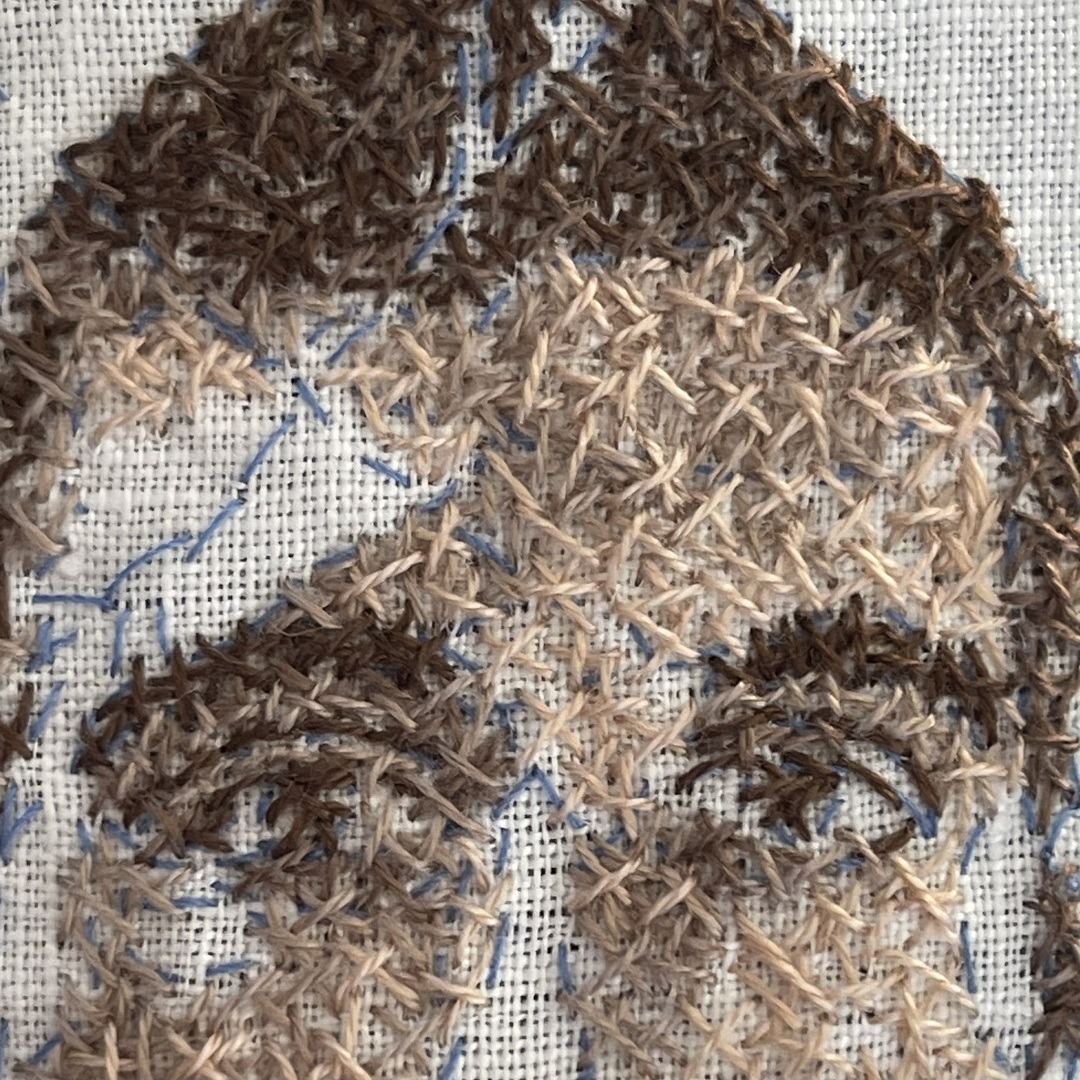
Sharon Peoples
Random cross stitch is a technique Sharon Peoples often uses in her hand embroidered storytelling work, as seen in Portrait of Oscar. Although she had very little information on her ‘secret sitter’, she wanted to add depth to the story she was creating, so she decided that layered stitching was the perfect approach to take.
‘I chose random cross stitch as it allows me to work in a painterly way, even on a very small scale. Placing the work in a jewellery box signifies the preciousness of people and their lives.’
The work was created for the Secret Sitter exhibition in 2022, where artists were invited to make portraits of other artists. Sharon portrayed Oscar, his treasured copper light fitting and the place he loved to hang out most – a light-filled loft. It was a challenging prospect, but when Sharon found a light blue jewellery case at a thrift shop, things began to fall into place.
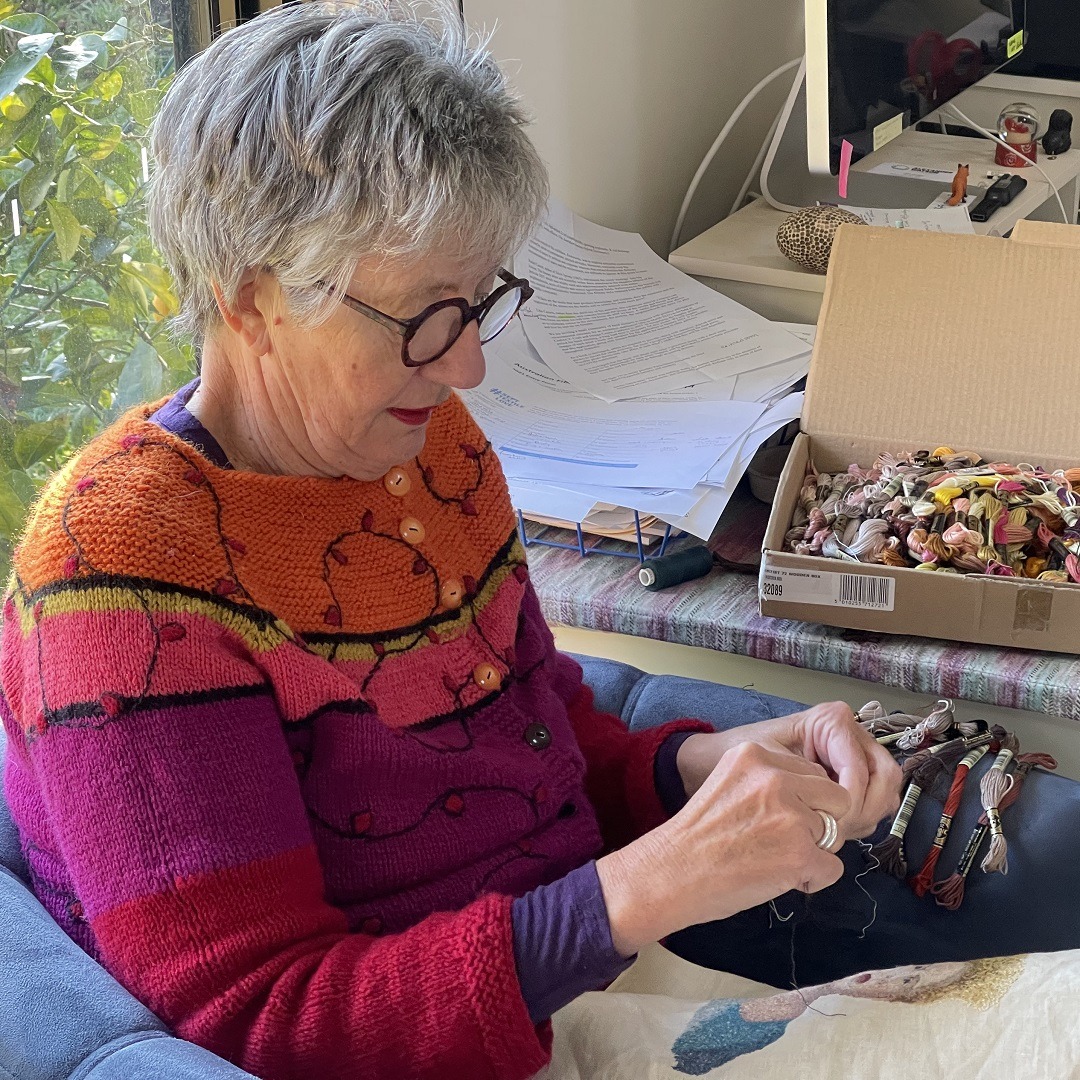
Sharon Peoples is a textile artist based in Canberra, Australia. She explores plants and gardens, as well as people and their inner ‘secret gardens’. Sharon was a finalist in the Seed Stitch Contemporary Art Award 2022 at the Australian Design Centre, Sydney, NSW.
Artist website: sharon-peoples.com/
Facebook: facebook.com/sharon.peoples.12
Instagram: @sharonpeoplesstudio
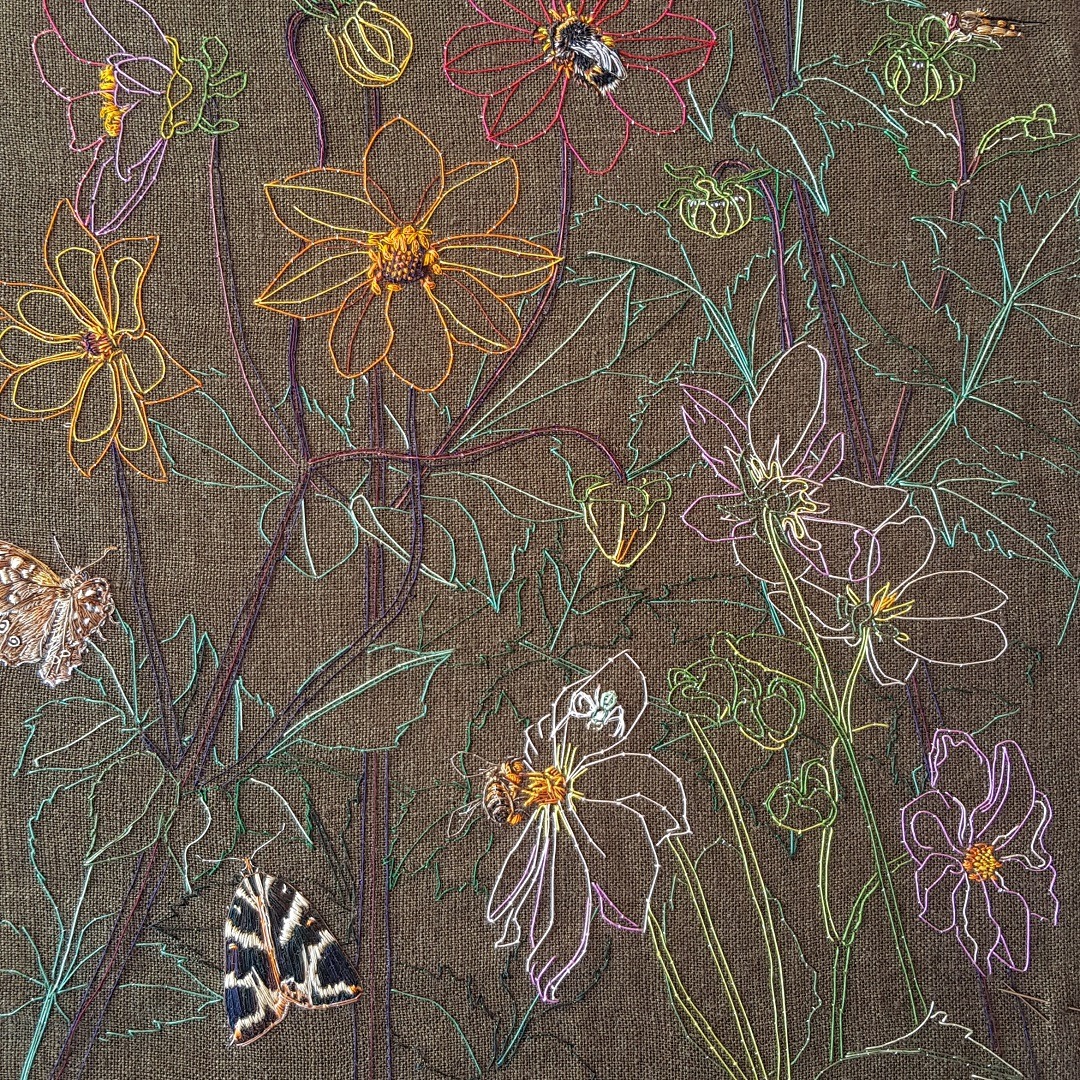
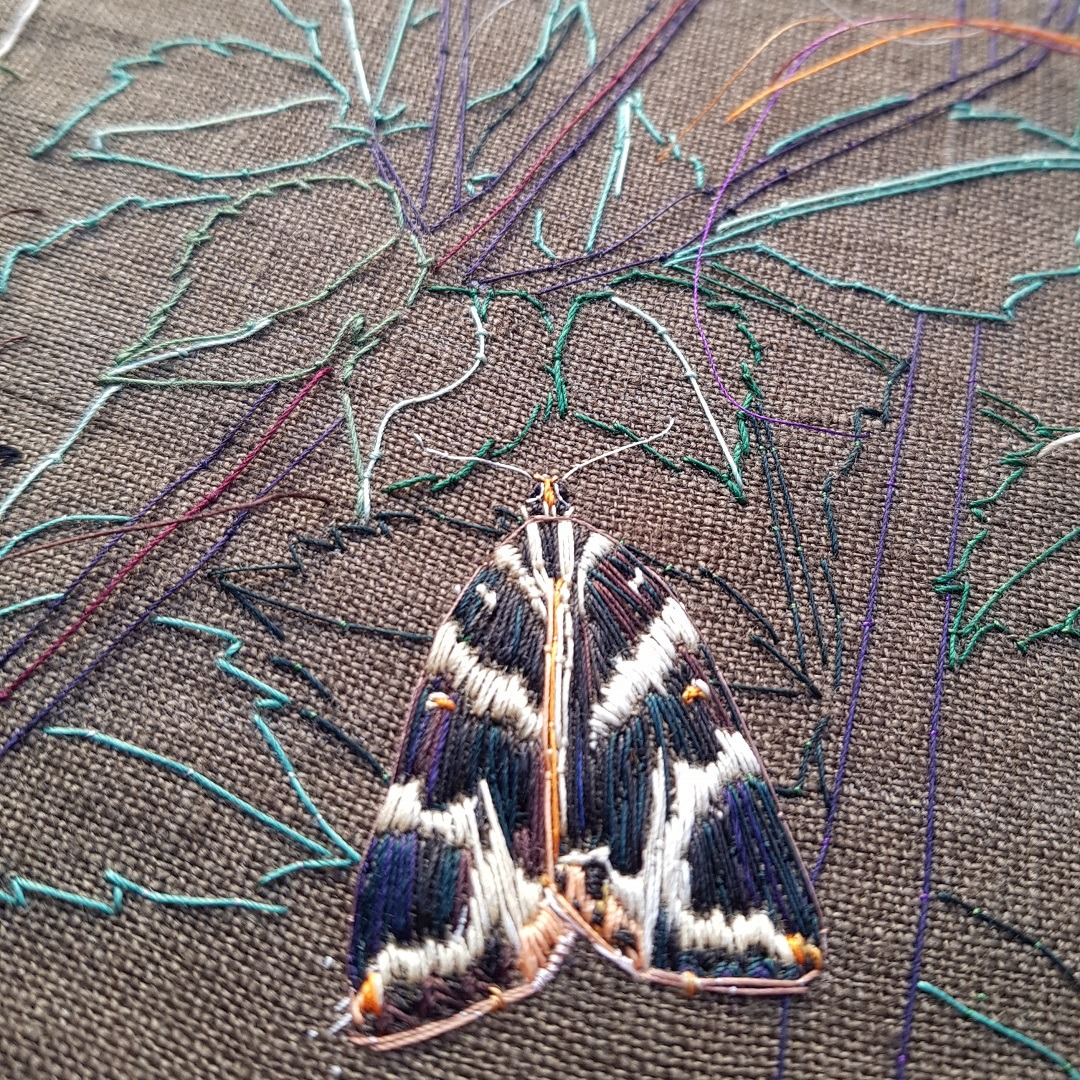
Diane Butcher
Couching becomes the focus and not just the outline stitch in Diane Butcher’s elegant work, Dahlias. She created this work as a ‘thank you’, giving a nod to the importance of nature and our suburban back gardens.
Dahlias have a special significance to Diane. After she moved back home from Devon, to help her mum look after her dad, when his dementia moved on suddenly, she sowed far too many Dahlia seeds. But this became a positive when things were difficult – something to care for, bring joy, and a reason to have a ten minute break.
Diane has always enjoyed using couching to create sinuous lines, and decided to create this work mainly with couching. Her work usually includes lots of detail and intricate layers of thread, which she describes as absorbing, but sometimes restricting.
‘I went back to my first love, line, for this piece. Couching feels like drawing with thread and it was the perfect way to describe the sculptural forms of the Dahlias and convey a simple message.’
The outcome is an exquisite, delicate work that focuses on the details, the beauty of the Dahlias themselves, and their visiting insects.
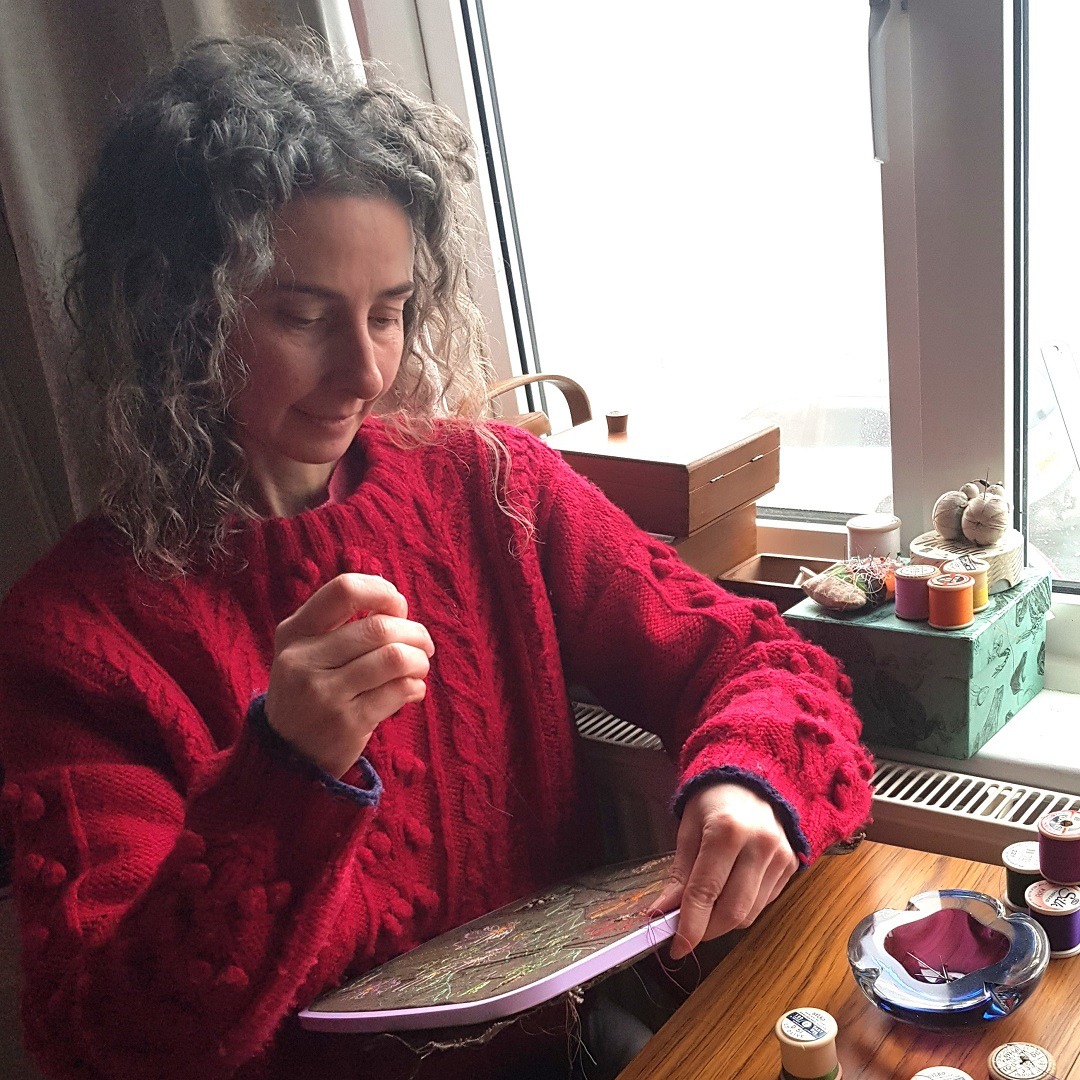
Diane Butcher is an artist based in south-east London. Her hand embroidery works are based on details and observations of the natural world.
Artist website: dianebutcherhandembroidery.com
Instagram: @dianebutcher.embroidery
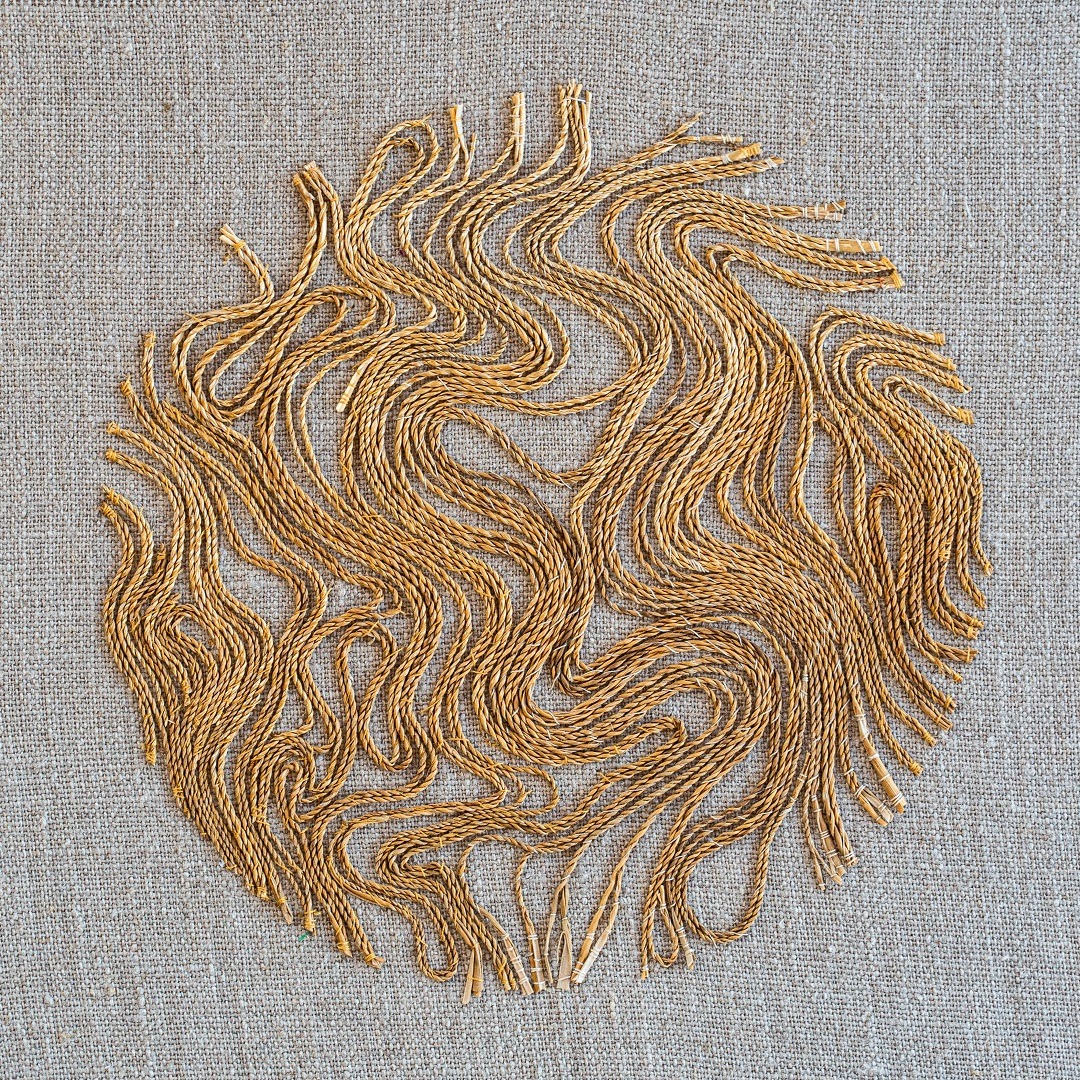
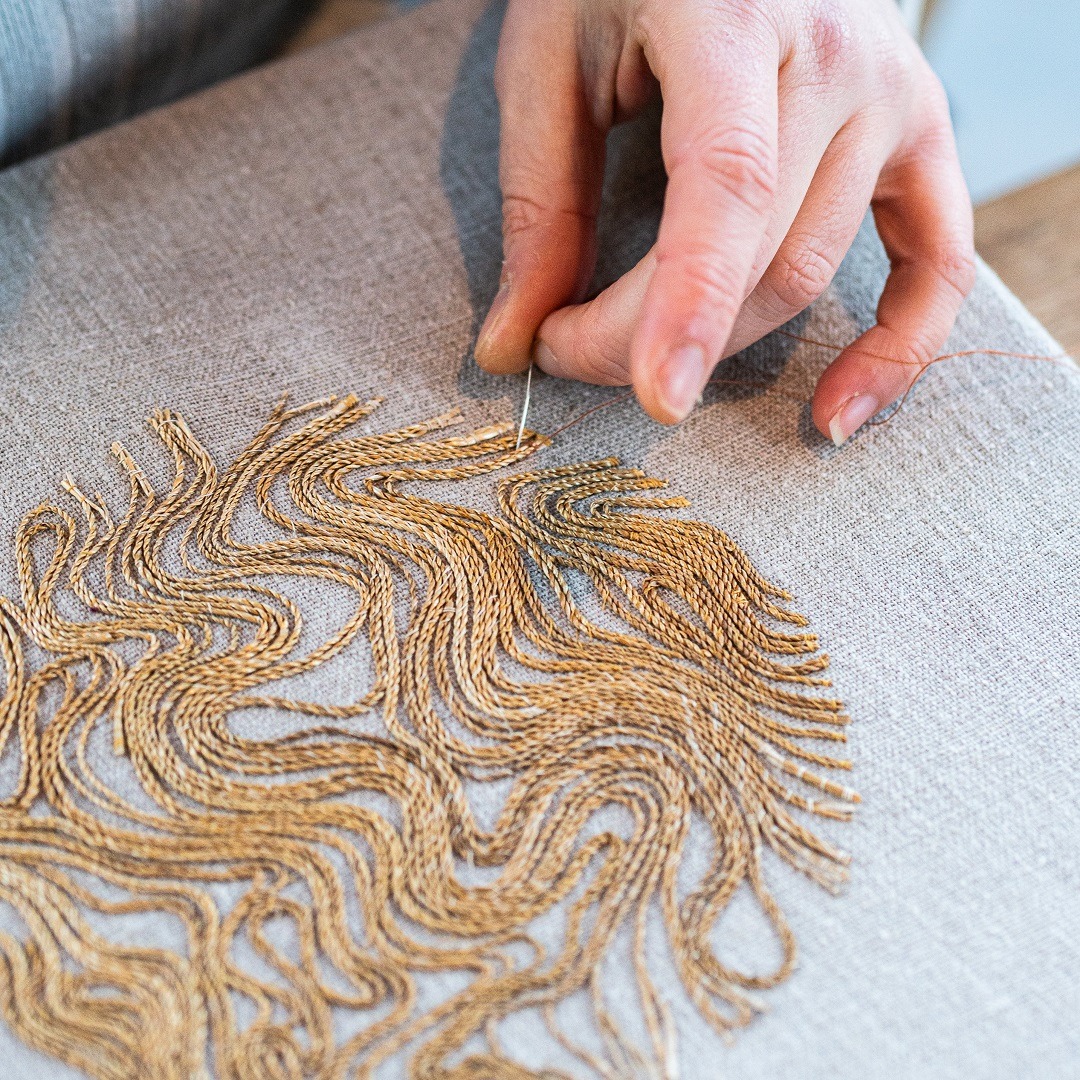
Hanny Newton
Couching is also a favourite technique of Hanny Newton. She loves its beautiful simplicity. One thread is laid on the fabric, then it’s secured by stitching another thread over it. For Hanny, this simple technique opens up a world of potential. Small changes, in colour, material, or scale, can provide many possibilities for experimentation.
‘I am interested in the way couching can become a drawing tool, to explore line quality. For me, it’s all about having a few techniques that I know really well – that way I can go deep.’
Hanny chooses to explore couching in great depth, rather than jumping from stitch to stitch, which wouldn’t allow her to question, delve and push boundaries in the same way.
In her series exploring complexity, Hanny uses couching to ‘grow’ designs that are more than the sum of their individual parts. The key ingredient is the imperfection of the moment. When the work evolves in its own way, she finds that the outcomes are more interesting. The threads layer up, creating flow, depth and movement that she could never plan.
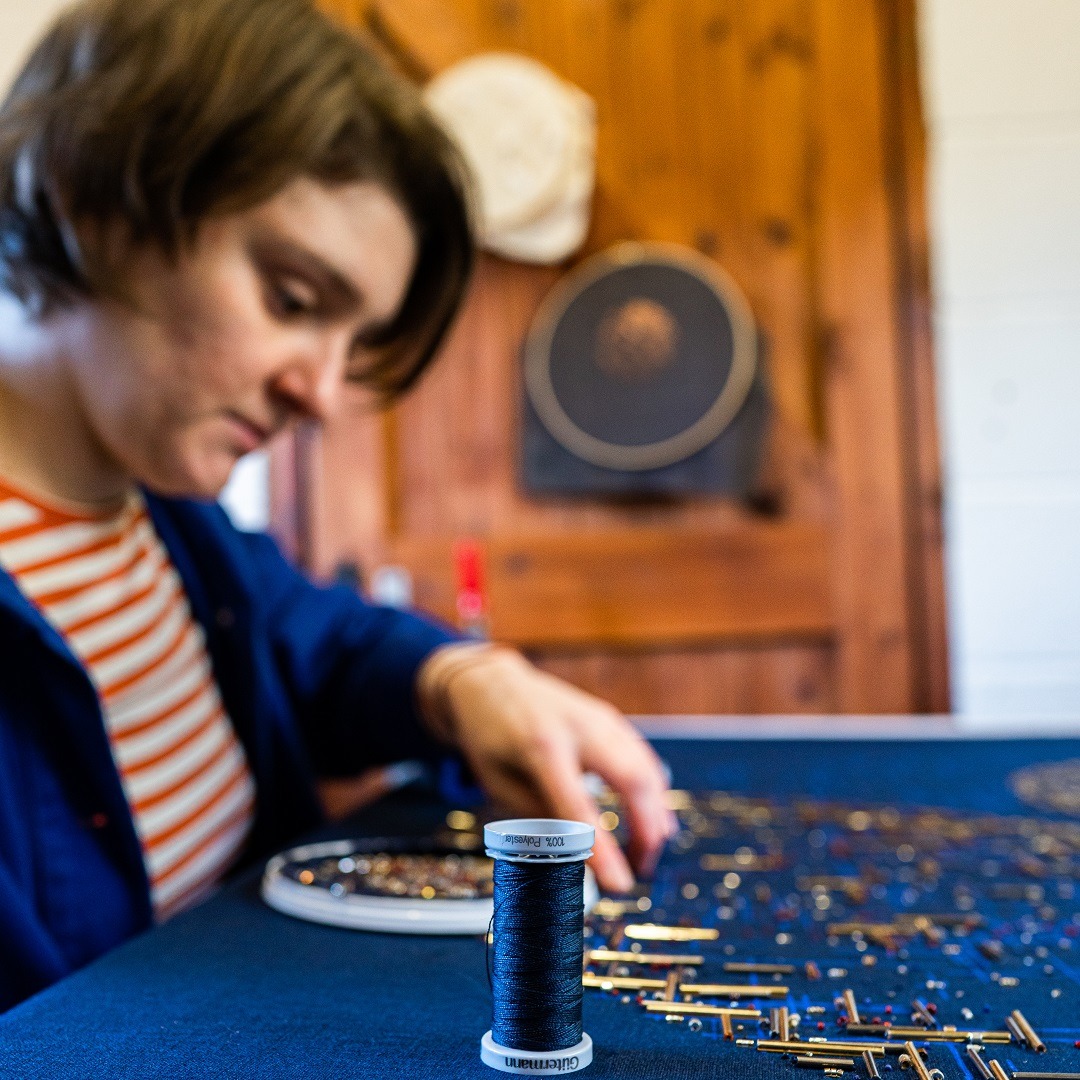
Hanny Newton is an embroiderer specialising in contemporary metal thread embroidery. She is based on the Shropshire/Powys border, UK and works with interior designers and art consultants on projects worldwide. Hanny also teaches in the UK and internationally, including at the British Museum, and West Dean College.
Artist website: hannynewton.co.uk
Facebook: facebook.com/hannyembroidery
Instagram: @hannynewton
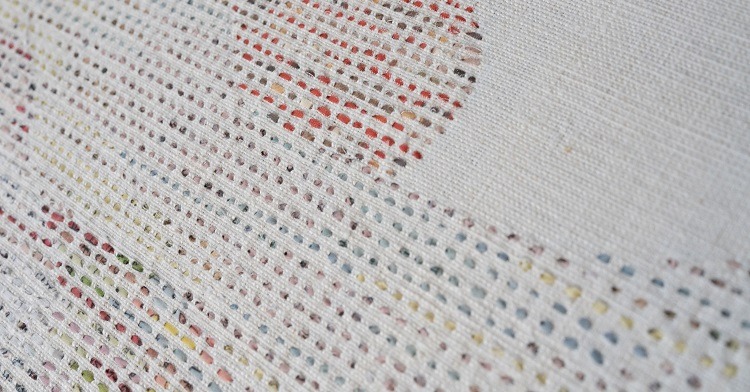
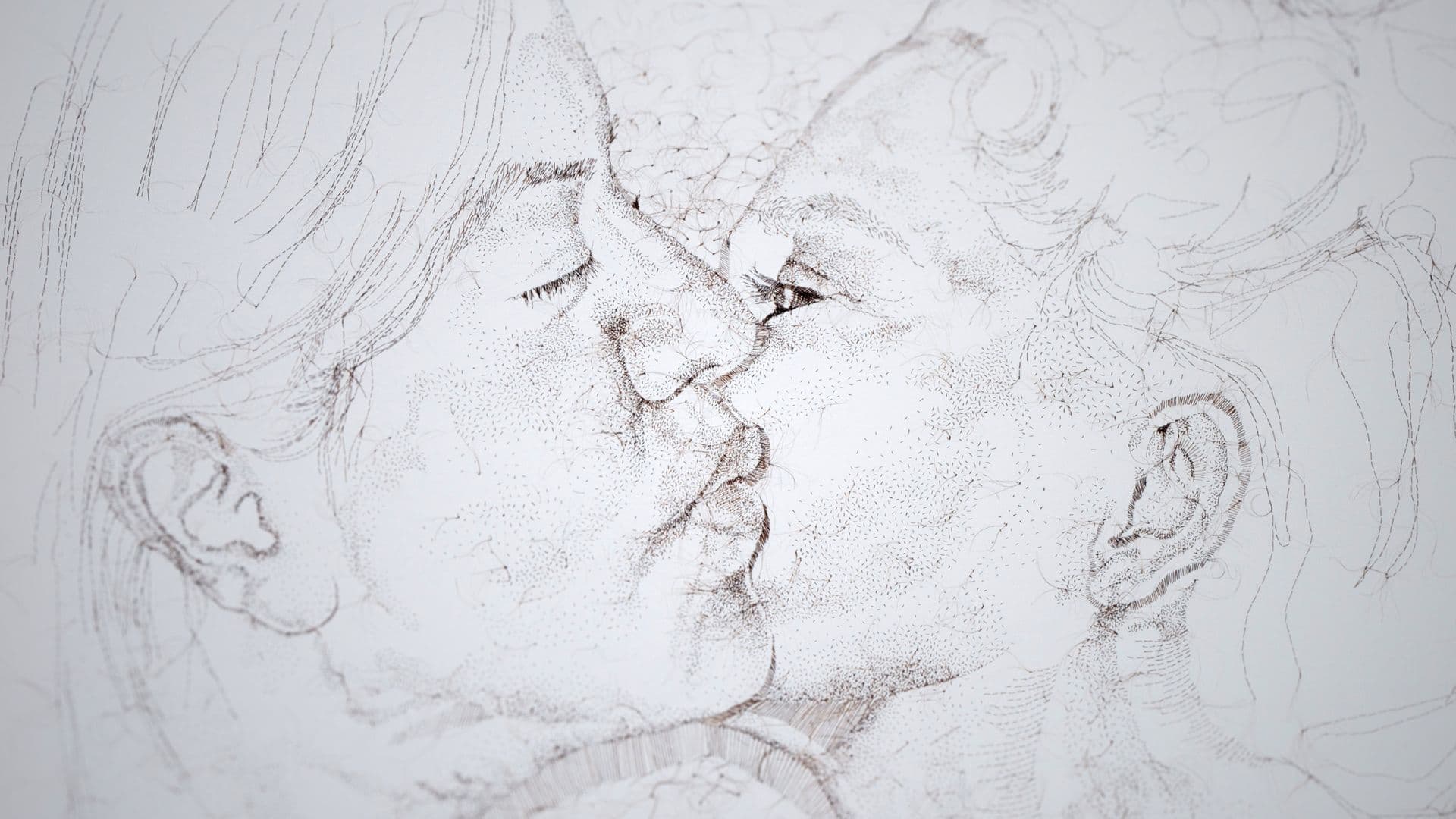
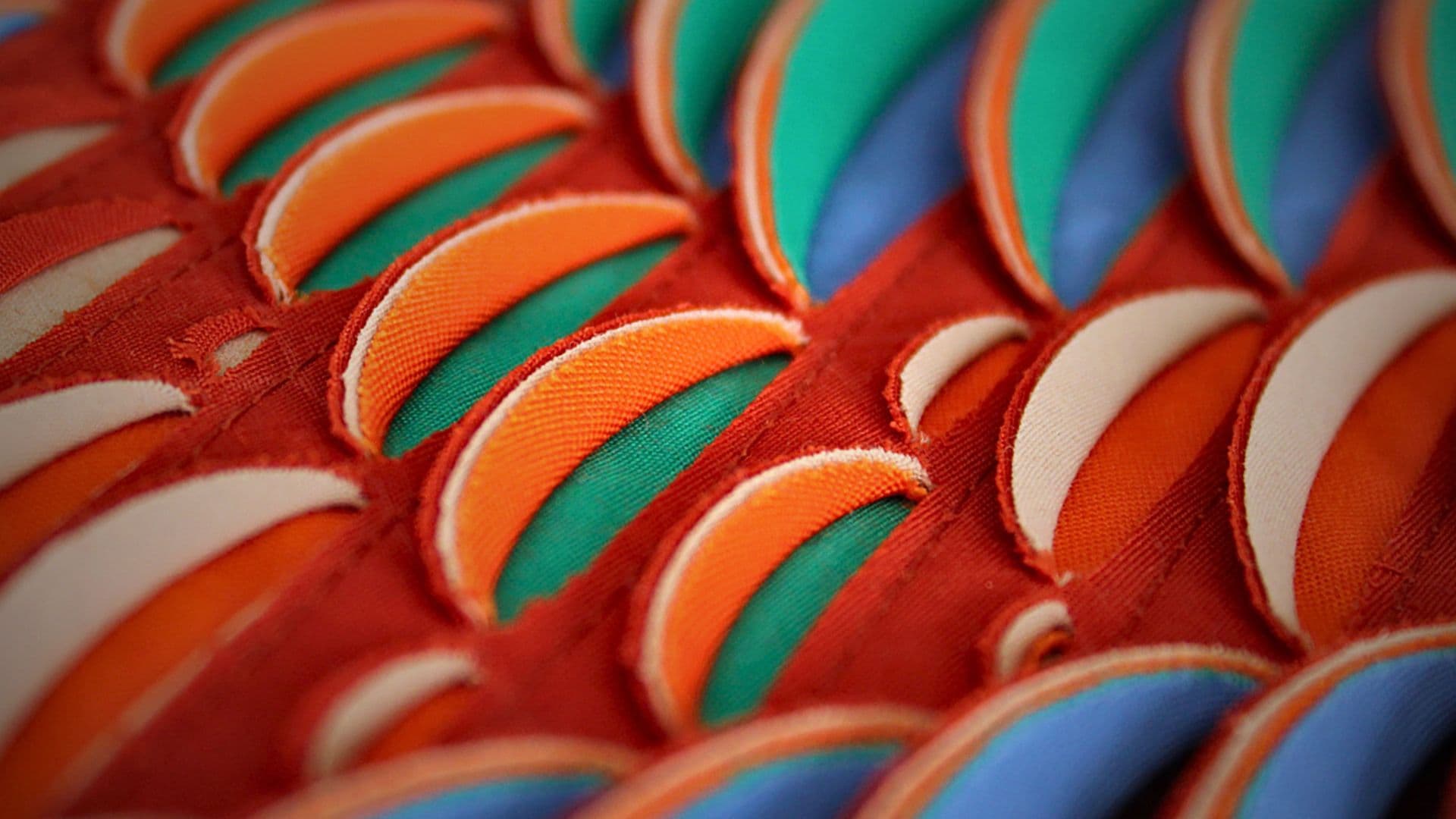
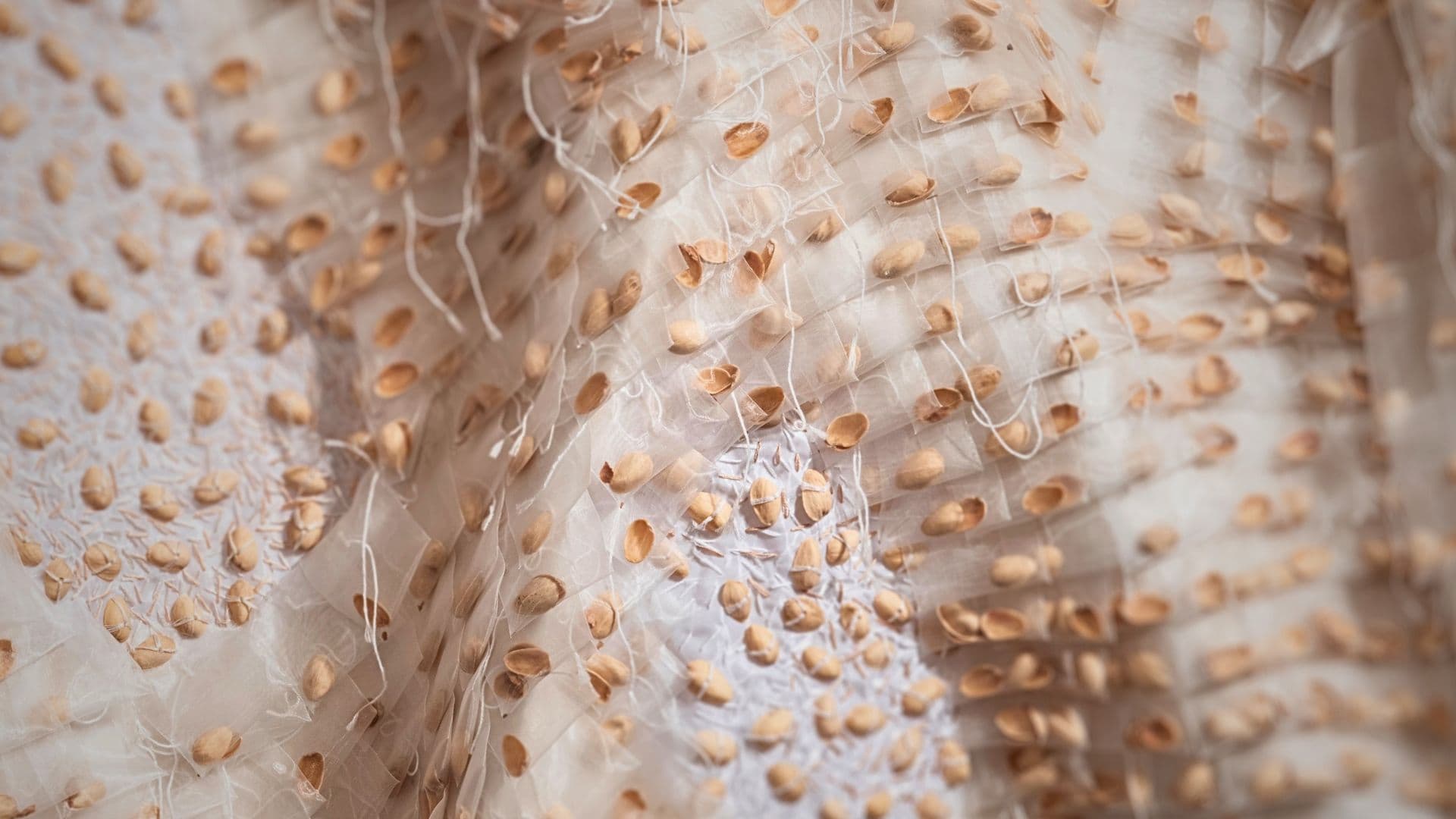
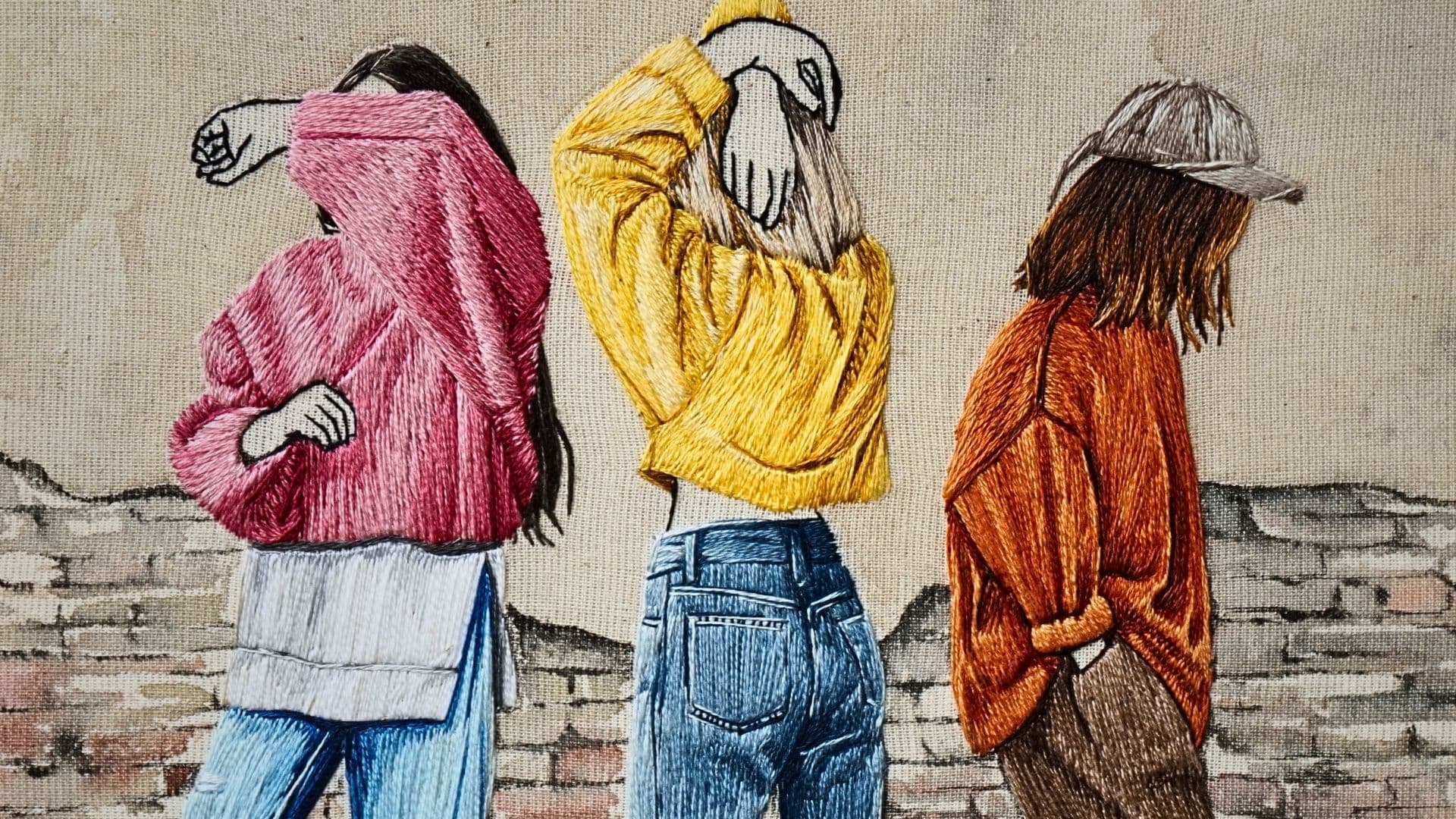
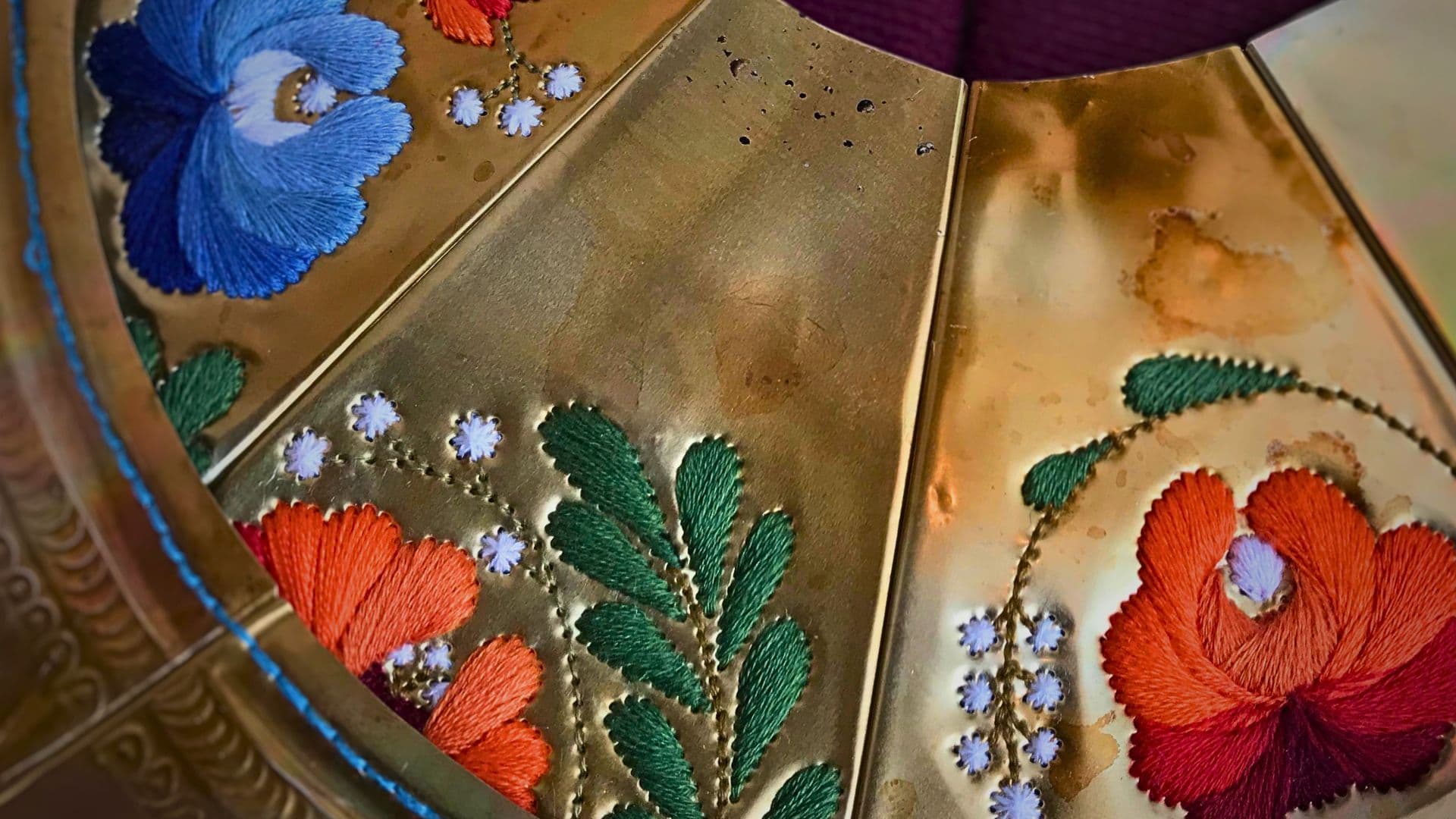
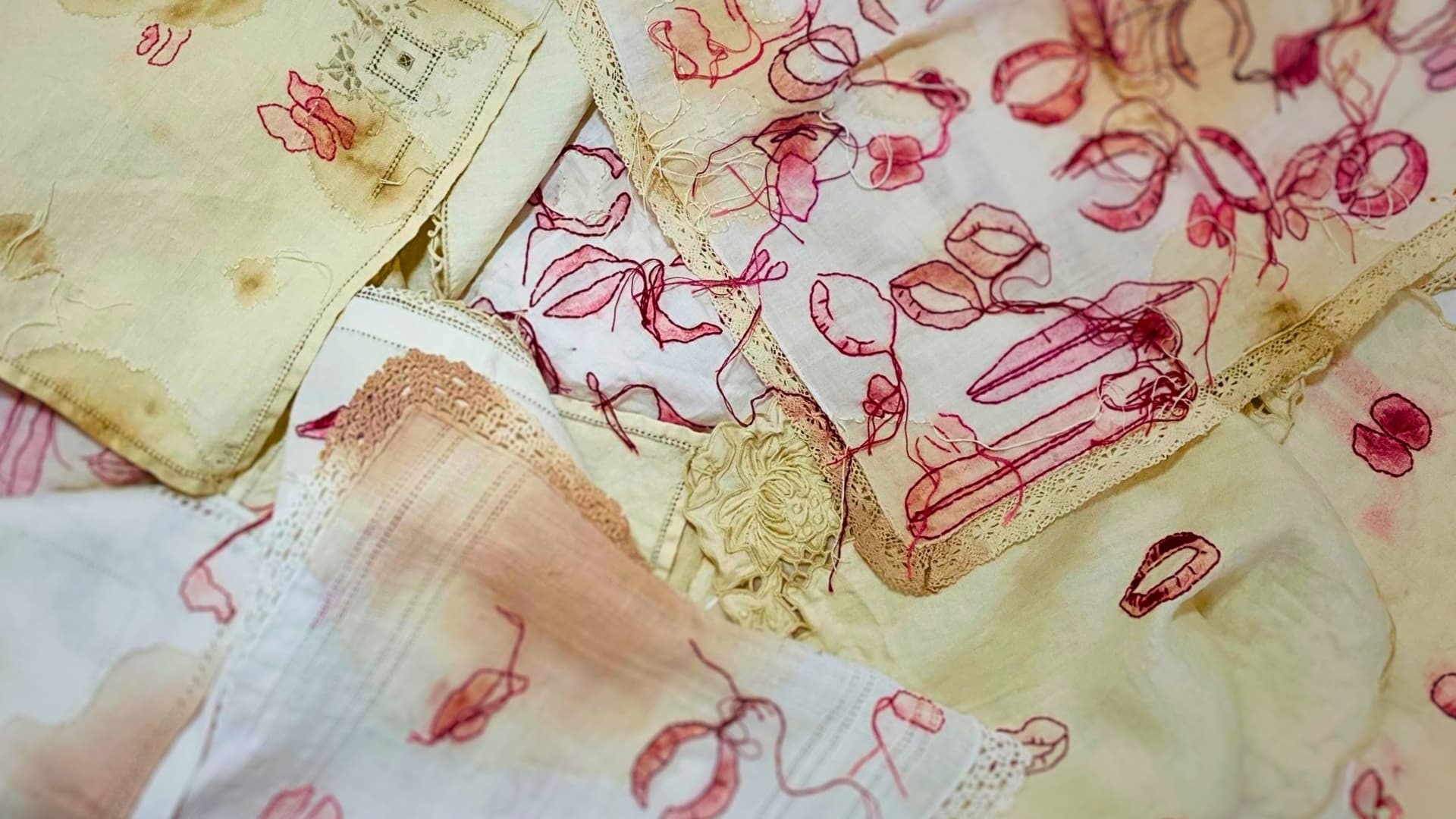
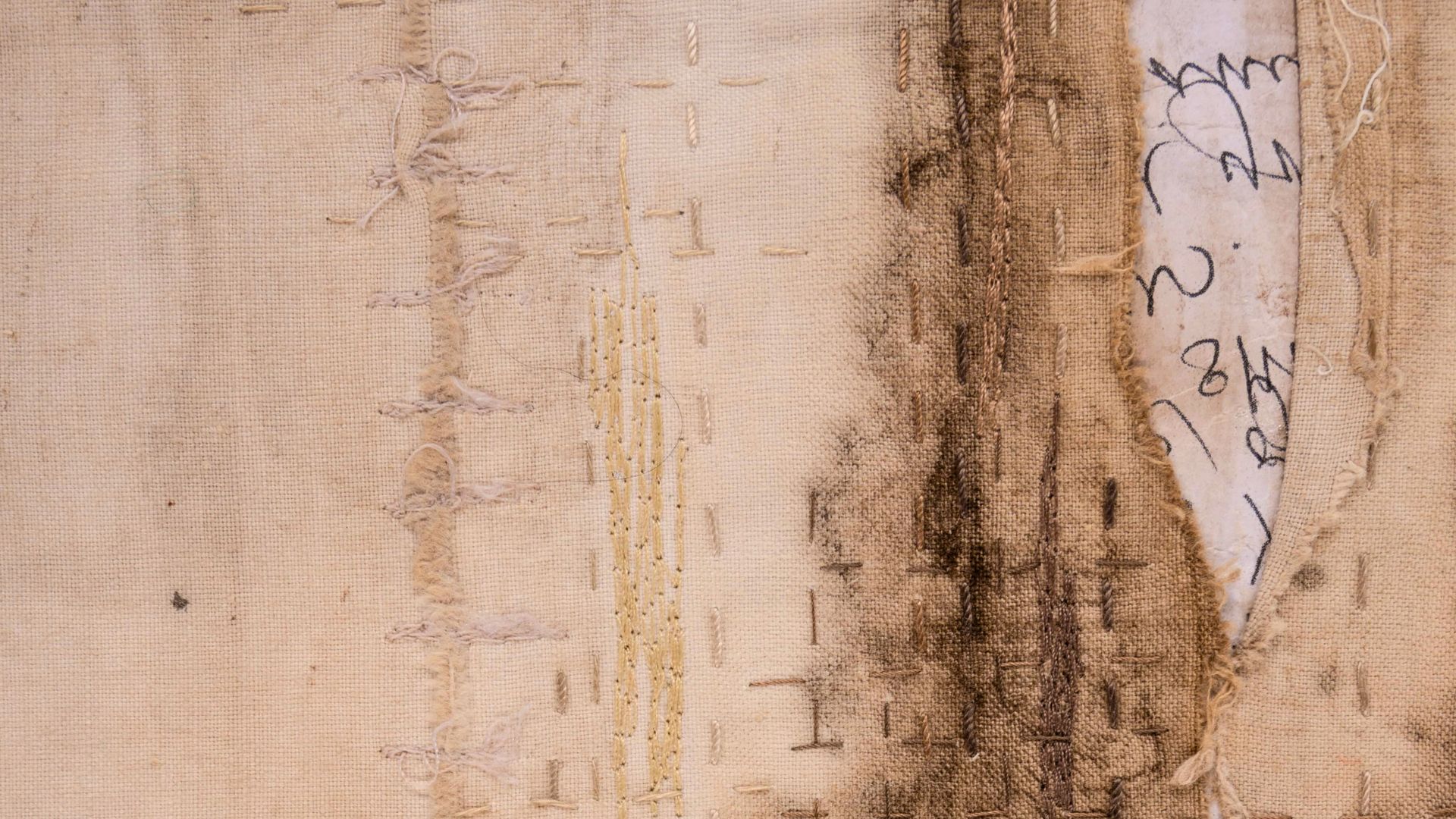
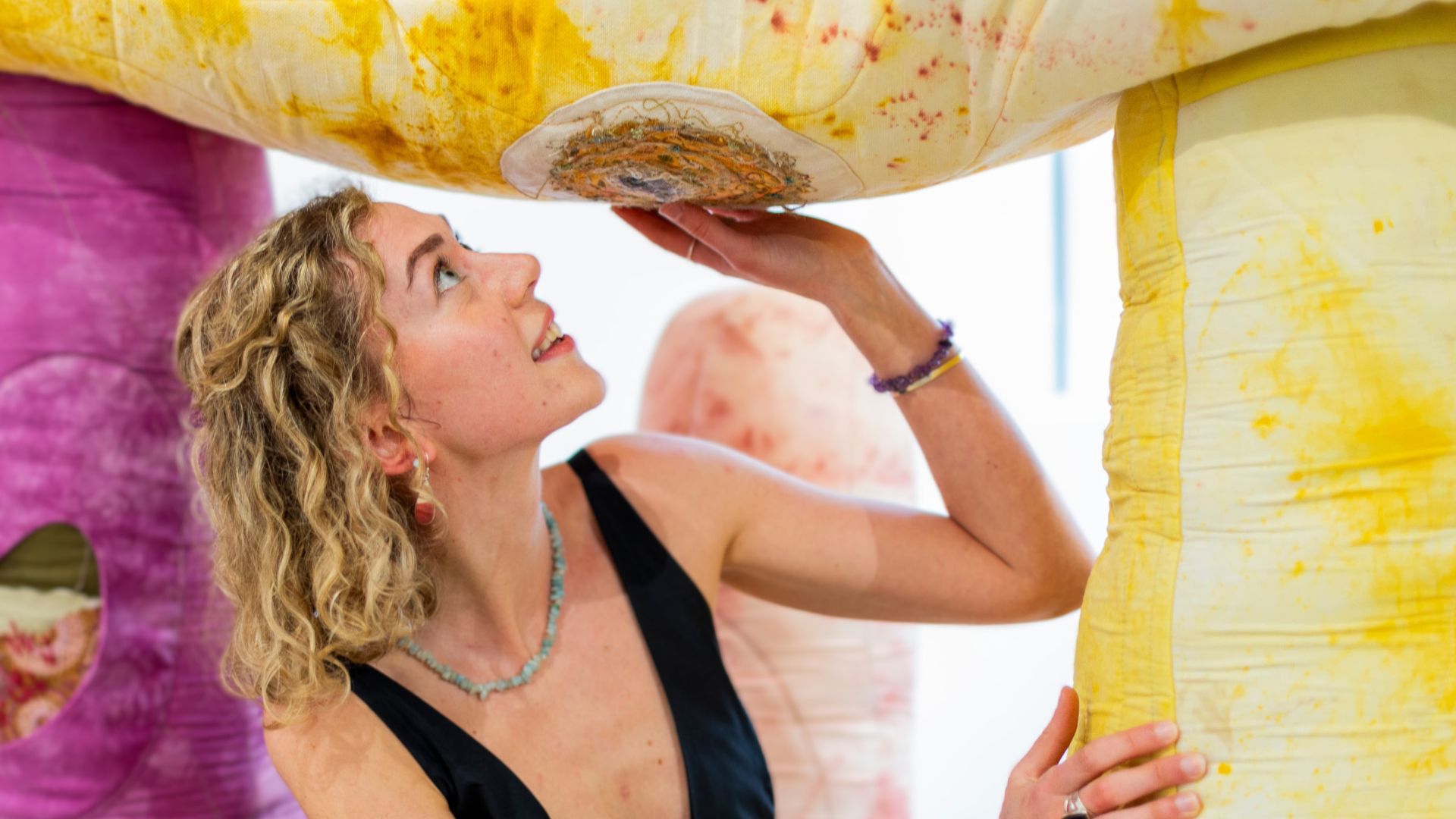
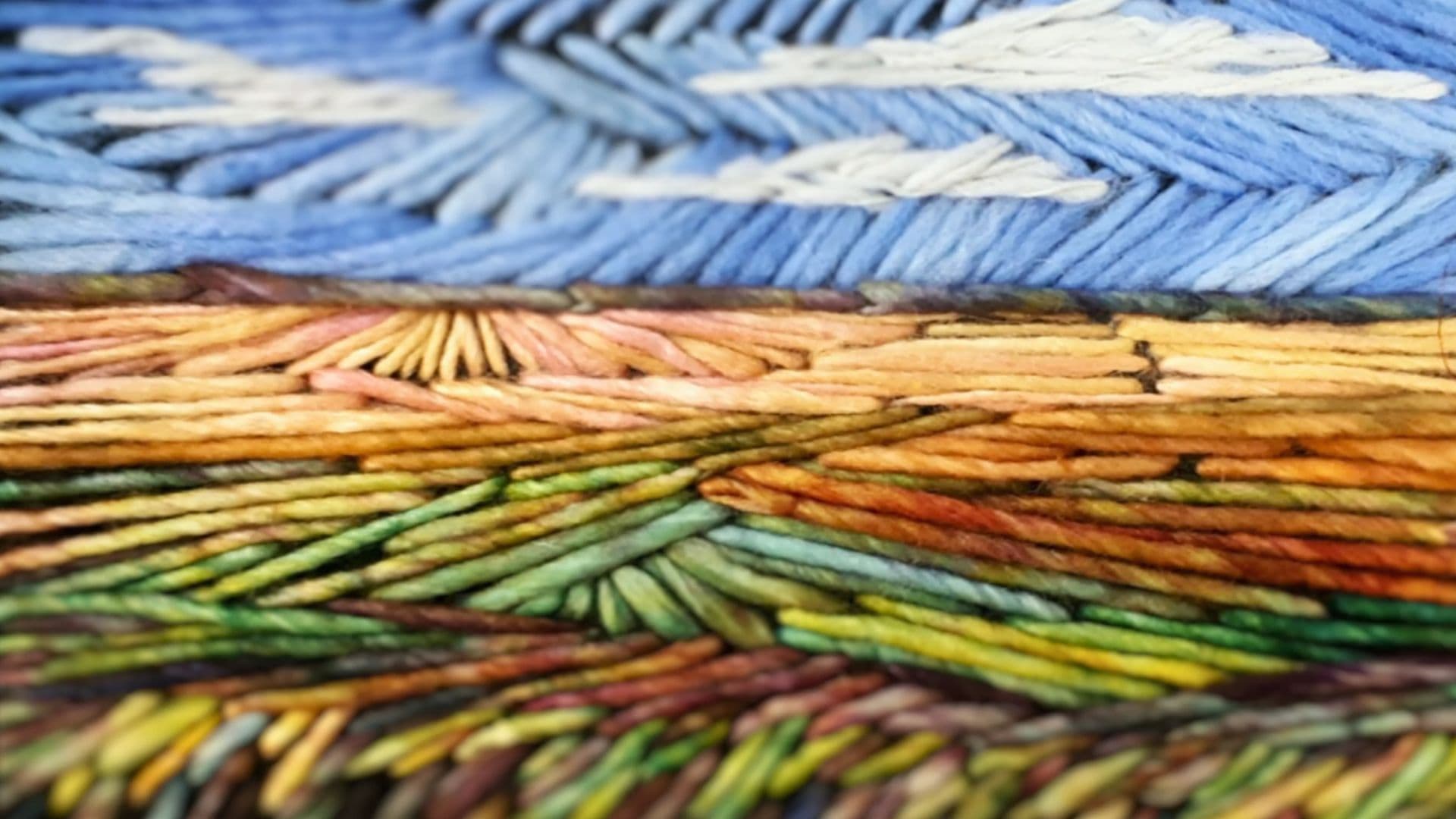
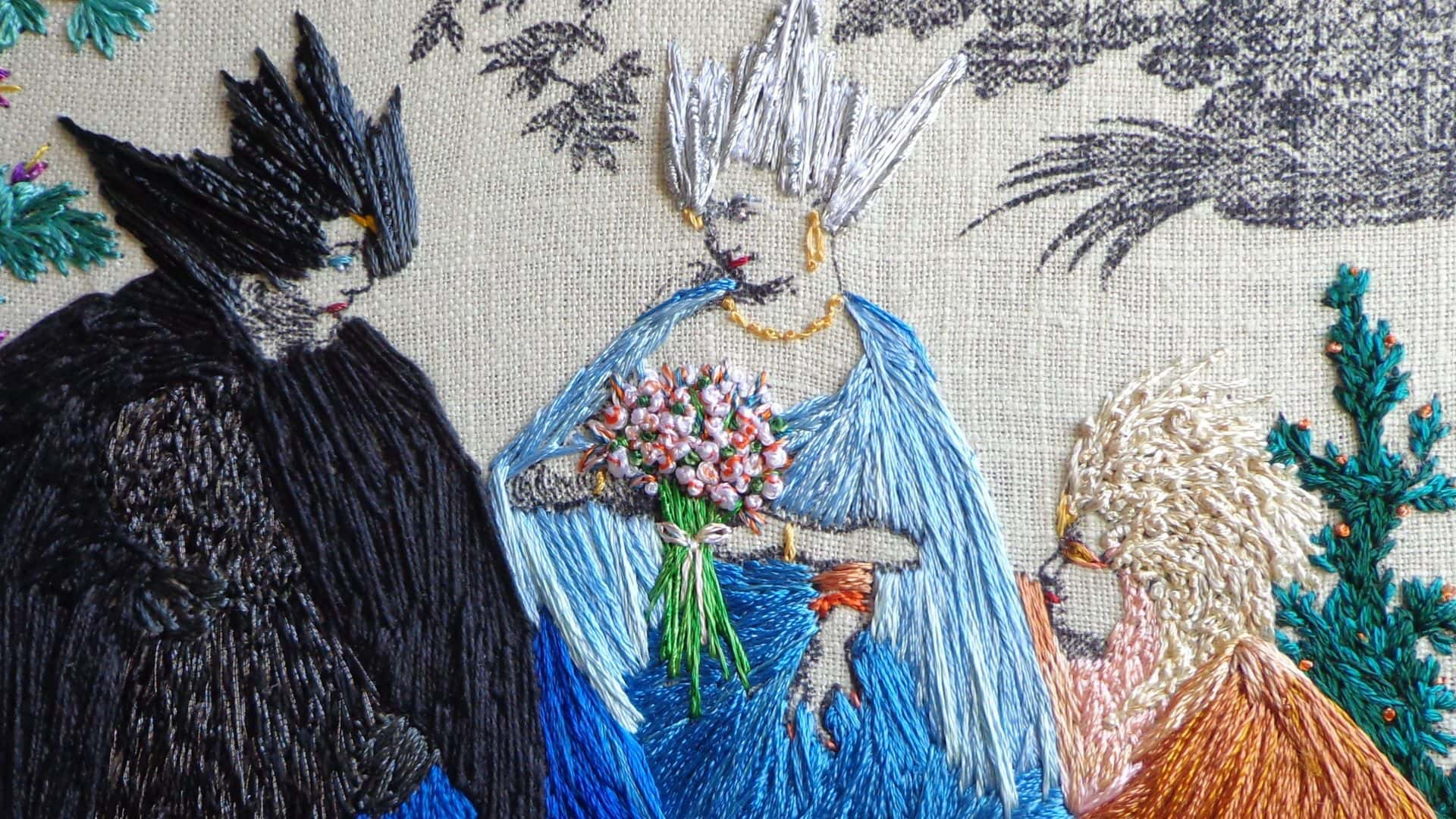
1 comment
Lesley Jackson
My favourite stitch is stem stitch because it has a gentle rhythm, takes curves well and has good texture. It has a few variations and can be stretched along a line. It’s great for ropes and vines but can even be used as a filling stitch.